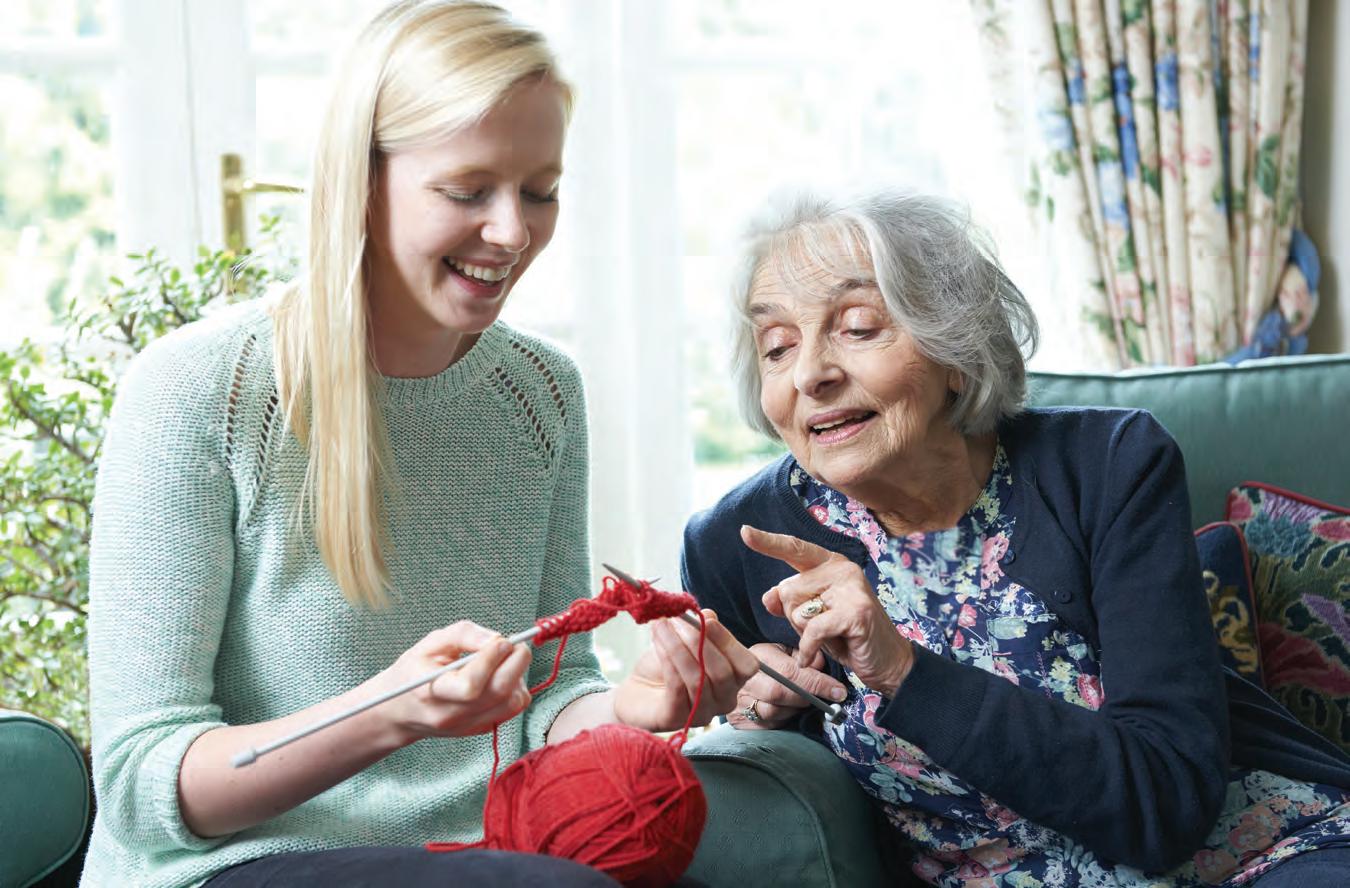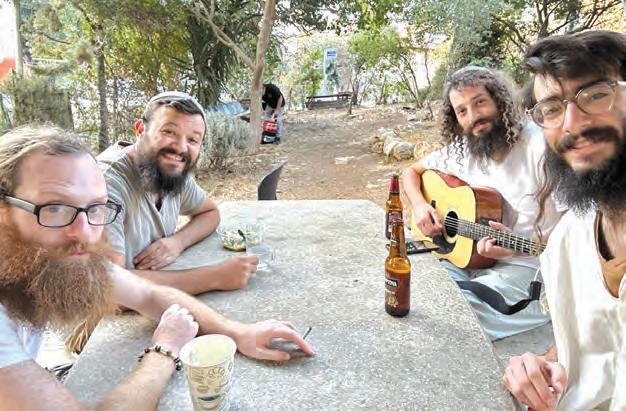






As the long days of summer draw to a close, we begin to feel a subtle shift in the air. The heat that once defined our days starts to wane, and the carefree rhythm of the season begins to dissipate. September signals the end of summer, the start of a new school year, and the shifting of the seasons.
The month of Elul arrives without fail, bridging the gap between the warmth of summer and the introspection of the Yomim Noraim. As the shofar sounds each day, its piercing call is both a reminder and an invitation. It beckons us to awaken from our summer reverie and begin the spiritual preparation for the days ahead. The shofar’s call cuts through the lingering haze of summer, urging us to reflect on our lives, our actions, and our relationships. Where have we wandered? What paths have we strayed from that now need correction?
During this time of year, I am inevitably reminded of the famous story told by the Divrei Chaim of Sanz (1793–1876), the founder of the Sanz Chasidic dynasty. He recounted the tale of a man lost in a forest, who had wandered for days, desperate to find his way out. When he encountered another traveler, his heart lifted with hope. Surely this person would guide him to safety. But the traveler, too, was lost, having roamed the forest without finding the way out. However, the traveler offered wisdom: “Do not take the path I have been following, as that will lead you astray. Let’s look for a new way out together.”
This story, like the end of summer itself, invites us to reflect on our own journeys. As summer fades, so too should our reliance on paths that have not served us. Teshuvah, the theme of Elul, is about returning—seeking out the wrong turns we’ve taken and finding new, meaningful directions. The story’s poignant line, “Let’s look for a new way out together,” speaks to the power of community, of learning from others as we chart new courses in life. It is a reminder that although the task may be monumental, we are not alone. Elul and the journey toward the Yomim Noraim are communal. We can look to others for inspiration, whether it be a spouse, a friend, or a Rav.
This approach to Elul is not new but rather an ancient and enduring path. The values and mitzvos of our tradition are our compass, guiding us as we transition from the ease of summer to the introspection of Elul. The contrast between the laid-back summer and the structured reflection of Elul highlights the need to return to these timeless teachings.
As we grasp the last days of the fleeting summer, a part of us actually looks forward to Elul—not only because we can send our kids off to school but because we yearn for a fresh start and the opportunities that the new year brings. The lifestyle changes, the weather changes, and we, too, can change.
Wishing everyone a peaceful Shabbos, Aaron Menachem






By Margie Pensak
Rabbi Yehuda Grossman, of San Antonio, Texas, attended STAR-K Kosher Certification’s annual Food Service Kashrus Training Seminar, held in the agency’s Baltimore offices July 29-31, to gain more knowledge and confidence in the world of Kashrus.
“It definitely taught me a lot of know-how, but more importantly it teaches what not to do,” shares Rabbi Grossman, a Rabbi Aryeh Scheinberg Community Kollel yungerman. “I especially enjoyed the Q & A session during which Rav Heinemann answered pertinent questions, as well as hearing from experts in the field -- straight from the source as opposed to all the hearsay and confusion about different very controversial Kashrus areas.”
As the wife of a wholesale food distribution business owner who many people count on regarding Kashrus, Julie Goodwin was motivated to travel cross country from San Diego to join the Food Service Kashrus Training Seminar. “I was very honored to learn so many of the Kashrus updates; STAR-K has the highest standards!” shares Mrs. Goodwin. “I now have a lot of clarification and empowerment; I’ve gotten a lot of chizuk from all of this training.”
This seminar, which was coordinated by STAR-K Kashrus Administrator Sholom Tendler, was also attended by those from even farther away -- the Philippines, England, and Australia!
STAR-K’s popular back-to-back annual Kashrus Training Program, held August 5-8, in Baltimore, was attended by an equally diverse group of participants. Among them, Rabbi Menachem Tendler, Rav of Sha’arei Chesed Shul in St. Louis, Missouri.
“I attended the seminar to receive firsthand information of the challenges in the world of commercial kitchens,” mentions Rabbi Tendler. “We will be instituting policies and bringing equipment into our Shul kitchen to prevent shailos from even starting. I specifically appreciated the handson tour of the Marriott hotel and witnessing the years of experience being
shared.”
Rabbi Pinchas Gross, Rav of Kehillas Derech Chaim in Baltimore, attended the training program mainly because his newly built shul will have a social hall and kitchen – a first for the shul.
“I really enjoyed the program,” remarked Rabbi Gross. “I wanted to be up to date on the current Kashrus challenges and concerns. I was very impressed with the knowledge, ehrlichkeit and dedication of the STAR-K staff.”
Rabbi Yaakov Lederman, the Rav of Congregation Anshe Sfard in Louisville, Kentucky, will be putting the practical knowledge and policy-making skills he gained into immediate actuality as the newly appointed Rav Hamachshir of the The Louisville Vaad HaKashruth.





“It was incredible that everyone at STAR-K was so welcoming and helpful,” remarks Rabbi Lederman. “It’s reassuring that I have numbers to call whenever I need advice and for questions that arise.”
Rabbi Moshe Harari-Raful is a Rav of Keter Torah, as well as an eighth grade rebbi in Ateret Torah in Brooklyn, New York.
“I wanted to get a feel for how Kashrus is run, a hands-on behindthe-scenes experience that I could share with my students,” explains Rabbi Harari-Raful. “By going on tours - and experiencing factories, shechita, a mikvah, and the eruv – I gained so much from seeing things that I learned about in Gemorah and how they are applied practically.”
Participants of both seminars were addressed by STAR-K Kashrus administrative staff members about such topics as foodservice challenges and major Kashrus differences between Ashkenazim and Sefardim. They also benefited from a hands-on vegetable checking practicum and behind-thescenes tours of local kosher food establishments, a kosher supermarket, a kosher wedding hall, and kitchen tours of Doubletree by Hilton and Marriott Owings Mills Metro Centre. Another highlight of these programs was the concluding “Ask the Rav” session, where the participants’ Kashrus queries were answered by HaRav Moshe Heinemann.
As Rabbi Grossman sums it up, “I felt the power of a hierarchy and
the power of an organization that has clear delineation of responsibility and delegation of jobs, where people are respectful and humble and know how to work together is something we can learn from. This has been a highly empowering experience.”
“Baruch Hashem we are able to continue giving back to the tzibur and train another group,” concludes STAR-K Kashrus Administrator Rabbi Zvi Goldberg, coordinator of the Kashrus Training Program. “We have been doing this for more than 20 years and it is literally another generation. This is the first time we hosted someone whose father participated 20 years ago. With Hashem’s help we will continue another generation!”

On Thursday night August 8th, Mercaz Torah U’Tefillah hosted a community-wide Siyum on Seder Nashim as part of the Mishnah Yomi cycle. The delicious felishig ‘9 Days’ siyum was sponsored by Dr. & Mrs. Yossi Scheller LZN his father R’ Avraham ben R’ Shmuel Helavi Z”L.
Everyone enjoyed Divrei Bracha from the Zidichover Rebbe of Baltimore, followed by the siyum from Dr. Scheller. Rabbi Duvi Rubin, Rav of Ohr Yisroel, delivered the keynote address and was mechazek everyone as he stressed the Chashivus of learning Mishnayos on a daily basis.






By: Elliot Cahan
United Airlines has a slogan: “Good Leads the Way.”
I don’t really think so highly of United these days since they seem to always be one of the first airlines to cancel flights to Israel. However, despite all the challenges over the last 10-11 months, there has been so much good, and we must let good lead the way.
The picture is an example of the good that has emerged from the darkness.
The soldier pictured is not religious, but he has committed to wearing tefillin every day. These tefillin were generously given to me, and I was asked to find them a new home. Thanks to my good friend and former
Rabbi, Dovid Gottlieb, (Baltimore’s Shomrei Emunah) this soldier now has a pair of tefillin.
Rabbi Gottlieb works for Tzalash, an organization that assists with the spiritual needs of soldiers. The soldier was provided with a brand-new, heavy-duty container to hold and protect the tefillin. These tefillin are inscribed with the name of a soldier who has fallen in battle, HY”D, and can no longer wear them. This particular pair is in memory of our beloved alumnus, Maoz Morell HY”D.
When Rabbi Dovid Gottlieb sent me this picture earlier today, I was truly lost for words. We can never completely fill the void left by the loss of Maoz, but with the help of some incredible individuals, we have

When Rabbi Dovid Gottlieb (right) sent me this picture (left), I was truly lost for words. We can never completely fill the void left by the loss of Maoz, but with the help of some incredible individuals, we have managed to fill that hole just a little bit today.
managed to fill that hole just a little bit today.
Good really does lead the way.



We know the familiar story: Akiva, the illiterate shepherd who became, with his wife’s unswerving support, one of our greatest sages. Now, Avrohom Yom Tov (Abie) Rotenberg us how to truly understand the story of Rabbi Akiva, in all its depth and glory. Who was this man, who even Moshe Rabbeinu hailed for his greatness? Whose life was so difficult and yet who serves as our model of optimism, hope and, above all, emunah?
This work of Torah scholarship holds our attention with its absorbing details and often surprising insights. We will discover the many facets of this great sage – and we will be inspired.
BY ABIE ROTENBERG






BY THE SAME AUTHOR:










BJH: Tell us about yourself.
Sara Strobel: My name is Sara (Gerstenfeld) Strobel. I have a master’s certificate in music production and engineering which led me to found the Baltimore branch of Ratzon, a girls’ performing arts program, which serviced the Baltimore community for 10 years. In 2021, with the support of my husband and a small group of motivated women, I founded Elevate, an organization for young married women in the Baltimore community.
BJH: What inspired you to found Elevate?
community. So, along with Mrs. Bracha Poliakoff, I put together a think tank of 25 motivated women overseen by Rebbetzin Chani Haber of Norfolk, VA who works for CORE, an international organization that guides mentors of female leaders such as kallah teachers, limudei kodesh teachers, and rebbetzins. From that think tank, Elevate was born!
BJH: What is Elevate’s mission and goal?
Gerstenfeld is our Associate Director and is an incredible asset to our team!
BJH: What kinds of events does Elevate offer?
SS: Elevate offers weekly chaburas, chabura round-ups, large community-wide events and shuirim, and virtual bursts of inspiration sent through email or WhatsApp.
BJH: Can you please explain the structure of the Elevate chaburas?

SS: Elevate was born in 2018 when my husband and I were having a conversation about the soaring divorce rates among young married couples. We felt that the frum community lacks support for young married women. It is often difficult for young mothers to attend shul which makes building a relationship with a rav or rebbetzin challenging. Additionally, post-Covid women were tired of virtual isolation and were craving a sense of
SS: Elevate provides married women in their 20s-early 40s with opportunities for growth, connection, community, and mentorship. Elevate provides an avenue for women to build a long-lasting and meaningful kesher with mentors in the Baltimore community who they can look to for hadracha and support.
BJH: Who else is part of the Elevate team?
SS: Baruch Hashem, we have tremendous support from the Baltimore community. Elevate operates under the guidance of Rabbi Yaakov Hopfer and Mrs. Shifra Rabenstein acts as my advisor and personal mentor. Additionally, Mrs. Zehava

SS: Our six-week chabura sessions allow women to learn from one of our incredible mentors in an intimate setting alongside a small group of other women. We have several amazing chabura leaders, all popular teachers and mentors from the Baltimore community. The chabura topics cover a wide variety of areas such as, shalom bayis, mesilas yesharim, parenting, and emunah. There is a chabura for everyone as we offer chaburas in the daytime, evening, and even on the weekends to accommodate everyone’s busy schedules. Chabura registration is limited to a small number of women which allows for meaningful and genuine learning and connection to the mentors.
BJH: What is a chabura round-up?
SS: As I said, each chabura session spans six-weeks. At the end of each chabura session we offer a larger event that includes a shiur and refreshments for anyone who participated in any of the Elevate chaburas during the prior session. The round up events allow women to reconnect with other chabura participants
and mentors and meet new participants as well.
BJH: How many women currently participate in Elevate?
SS: Baruch Hashem we have certainly grown from that 25-women think tank. We now have about 70 women participating in our weekly chaburas and over 100 women attending our large events.
BJH: Elevate is hosting its 20242025 Kickoff event this fall; can you please tell us about it? Who should attend?
SS: Yes! We are so excited to host our third annual kickoff event in November B’ezras Hashem. This event will include a keynote and delicious refreshments. Our kickoff events are a great way for women to meet all of our mentors and gain a small taste of what their chaburas entail. This event is open to all young married women in the Baltimore community. Keep an eye out for more information in the coming weeks. We strongly encourage anyone who is looking for opportunities for growth, connection, community, and mentorship or just a fun and inspiring night out to attend!
BJH: That sounds incredible! How can our readers learn more about what Elevate has to offer?
SS: Anyone who would like to sign up for a chabura or learn more about what Elevate has to offer can visit our website at https://www.elevate2connect.com or contact us via email at elevate2connect@ gmail.com.
board the ship; fifteen were rescued. Police divers on Tuesday were still trying to get to the bodies of six people who are believed to have been trapped in the hull of the yacht, including a British tech magnate who was celebrating his recent acquittal on fraud charges with the people who had defended him at trial.

On Monday, when a storm rolled into Sicily in the early morning, a superyacht that had been moored about a half-mile offshore was struck by a tornado over the water and sank into the deep waters.
Twenty-two people had been on
The Bayesian, a 184-foot British-flagged yacht, is now laying 164 feet underwater in the deep water off Porticello, a depth that requires special precautions for rescuers.
Among those considered missing is Mike Lynch, who was once hailed as Britain’s king of technology, was cleared in June of fraud and conspiracy charges in a U.S. federal trial related to Hewlett Packard’s $11 billion takeover of his company, Autonomy Corp.
Also unaccounted for are Christopher Morvillo, one of Lynch’s lawyers, and Jonathan Bloomer, a chairman at Morgan Stanley International and the former head of the Autonomy audit committee who testified in Lynch’s defense.
The outing was intended at least in part as a celebration of Lynch’s acquittal and a “looking forward to what was coming next,” said Reid Weingarten, a Washington attorney and a member of Lynch’s defense team who was not on the yacht.
Karsten Borner, the captain of the Sir Robert Baden Powell, which rescued the survivors who managed to get into a lifeboat, said he was close enough to be able to see the Bayesian as the storm came in.
“A moment later, she was gone,” he said. “They said they went flat on the water and were sunk in two minutes,” Borner added, quoting the survivors.
Luca Cari, a spokesman for the rescue teams, said the search was proceeding much more slowly than that of another big shipwreck in Italy, the 2012 Costa Concordia cruise ship that flipped on its side off Tuscany’s coast, because of the depth of the wreck and the space divers have to maneuver.
“That was much simpler. Here, everything is more tight,” he said.
The yacht, built in 2008 by the Ital-
ian firm Perini Navi, was carrying 12 passengers and 10 crew. According to online charter companies, it had been available for charter for 195,000 euros (about $215,000) a week and was notable for its massive 75-meter-tall (246-foot-tall) aluminum mast, one of the tallest in the world.

A court in Yekaterinburg, Russia, convicted and sentenced Ksenia Karelina, a Los Angeles resident who has dual U.S.-Russian citizenship, to twelve years in jail last Thursday.
6:15 am Young Israel Shomrai Emunah M-F
6:25 am Southeast Hebrew Cong., Knesset Yehoshua M-F
6:30 am Beth Sholom Congregation M-F
Beit Halevi (Sfardi) M, T
Chabad of Silver Spring M-F
Ohev Shalom Talmud Torah OLNEY M-F
Young Israel Shomrai Emunah S YGW M, Th
6:35 am Ohr Hatorah M, Th
6:40 am YGW S, T, W, F
Magen David Sephardic Congregation M-Th
6:45 am Beit Halevi (Sfardi) S, T, W, F
Kemp Mill Synagogue M, Th
Ohr Hatorah T, W, F
Young Israel Shomrai Emunah M, Th
6:50 am Woodside Synagogue/Ahavas Torah M, Th Silver Spring Jewish Center M-F
Chabad of Upper Montgomery County M-F
6:55 am Young Israel Shomrai Emunah T, W, F
7:00 am Kemp Mill Synagogue T, W, F
Southeast Hebrew Cong., Knesset Yehoshua S Silver Spring Jewish Center S
Woodside Synagogue/Ahavas Torah T, W, F
Young Israel Ezras Israel of Potomac T,W,F
7:05 am Kesher Israel M, Th
7:15 am Kemp Mill Synagogue M, Th
Kesher Israel T, W, F
Ohev Sholom Talmud Torah/The National Synagogue M-F
Ohr Hatorah S
7:30 am Chabad of DC M-F Chabad of Potomac M-F JROC M-F
Kemp Mill Synagogue T, W, F
Southeast Hebrew Cong., Knesset Yehoshua M-F
Young Israel Shomrai Emunah S
Young Israel Shomrai Emunah (Sfardi) M-F
7:45 am YGW (Yeshiva Session Only) S-F
8:00 am Beth Sholom Congregation S
Kemp Mill Synagogue S Kesher Israel S
Ohev Shalom Talmud Torah OLNEY S
Southeast Hebrew Cong., Knesset Yehoshua S
8:00 am Chabad of Upper Montgomery County S
Woodside Synagogue/Ahavas Torah S YGW (High School; School-Contingent) S-F
Young Israel Ezras Israel of Potomac S Young Israel Shomrai Emunah (Sfardi) S
8:15 am Ohr Hatorah S Kehilat Pardes / Berman Hebrew Academy S-F
Silver Spring Jewish Center M-F
8:30 am Chabad of DC S Chabad of Potomac S JROC S Ohev Sholom Talmud Torah/The National Synagogue S Silver Spring Jewish Center S YGW (Summer Only) S-F
8:45 am Young Israel Shomrai Emunah S-F
9:00 am Chabad of Silver Spring S Kemp Mill Synagogue S
Before Shkiah, S-TH
Beit Halevi (Sfardi)
Beth Sholom Congregation
Chabad of Potomac
Chabad of Silver Spring
Chabad of Upper Montgomery County
JROC
Kemp Mill Synagogue Kesher Israel
Magen David Sephardic Congregation
Ohev Sholom Talmud Torah/The National Synagogue Ohr Hatorah
Silver Spring Jewish Center
Southeast Hebrew Congregation, Knesset Yehoshua Woodside Synagogue/Ahavas Torah
Young Israel Ezras Israel of Potomac
Young Israel Shomrai Emunah (Asheknaz)
Young Israel Shomrai Emunah (Sefarhadi) maariv
8:15
email ads@baltimorejewishhome.com
1:50 pm YGW Summer
2:15 pm Silver Spring Jewish Center M-F
2:20 pm YGW School Days
2:45 pm YGW S-Th
4:30 pm Ohev Shalom Talmud Torah OLNEY S-Th mincha
8:45
9:00


Karelina, a hobbyist ballerina and an employee at a Beverly Hills skin care clinic, was detained in January during a trip to her hometown Yekaterinburg, where her family currently lives, with Russian authorities accusing the woman of collecting “money in the interests of one of the Ukrainian organizations, which was subsequently used to purchase tactical medical supplies, equipment, weapons, and ammunition for the Ukrainian armed forces.”
According to Perviy Otdel (First Department), a civil rights group based in Russia, Karelina, 33, was arrested because she gave $51.80 to Razom for Ukraine (Together for Ukraine), a New York humanitarian aid organization. She made the donation while residing in the United States.
Russian authorities, according to Karelina’s relatives and friends, took away the woman’s phone after she made it to Yekaterinburg and ordered her to stay within the local area on January 2. Russian authorities may have found out about the donations after searching through her phone. On January 27, Karelina was arrested, after she met with officials in order to collect her phone.
Following news of her sentenc
freedom.
Vedant Patel, a spokesman for the U.S. State Department, said “we strongly condemn the Kremlin’s escalating domestic repression” and added that “we remain deeply focused and engaged.”
Russian news agencies reported that Karelina pleaded guilty to the charges during a closed trial. Mikhail Mushailov, Karelina’s lawyer, said that his client will try to appeal the ruling.
“She admitted guilt in part in transferring the funds but did not admit her intent to transfer the funds to the organizations where they were most likely received,” Mushailov said. “She did not assume that the funds she transferred would be used for anti-Russian actions.”
Since Russia’s February 2022 invasion of Ukraine, Moscow has targeted individuals who oppose the war. Additionally, Russia has detained several U.S. citizens on sham espionage charges, including Evan Gershkovich, a journalist for the Wall Street Journal, and Paul Whelan, a U.S. corporate security executive, both of whom were released on August 1 in an historic prisoner swap.
“Donating to a nonprofit organization…supporting the Ukrainian cause,


ing, the U.S. has yet to officially declare Karelina “wrongfully detained,” as it did with Gershkovich, Whelan, and others – a measure the detainee’s family and friends have urged the United States government to take.

Japan’s prime minister, Fumio Kishida, said last week that he would step down, bowing to pressure within his party to move on from his unpopular leadership.
Kishida, 67, whose approval ratings have plummeted in recent months, said at a news conference that he would not run in the governing Liberal Democratic Party’s leadership contest in September. The winner of that election will become the prime minister.
He said he believed that the party needed to show it was willing to make big changes. “The clearest way to do this is for me to withdraw,” he said.
Kishida, who took office in October 2021, has seen his ratings slide sharply over a political fundraising scandal within the party. His reputation has also soured over rising prices that have put pressure on households and the national economy.
His announcement creates political uncertainty in Japan, a crucial American ally, at a time of rising threats from China and North Korea. It is also likely to revive concerns that Japan could return to the revolving door of prime ministers that has characterized its political landscape in the past.
During Kishida’s time in office, he has worked closely with President Joe Biden to enhance military and economic cooperation between the two longtime allies and with South Korea, with whom Japan’s relations have long been strained. He significantly bolstered Japan’s military defense, breaking with decades-long precedent on spending restrains.
Numerous scandals within the Lib-
eral Democratic Party, which has governed Japan for all but four years since 1955, have led to widespread voter dissatisfaction, and the party has been searching for months for a potential successor to Kishida.
This year, Kishida dissolved his own faction within the party over a scandal involving campaign funds. The faction was found to have failed to report the equivalent of millions of dollars’ worth of political contributions in official reports.
Kishida was not directly involved in the scandal, but analysts said his low ratings reflected the public’s view that he could not exert the leadership needed to change the party.
The prime minister made various attempts to restore trust, including legislation to reform campaign finance rules, but ended up “with no cards left to play,” said Harumi Arima, an independent political analyst. “He decided to be responsible to his party and leave its future with the next leader.” (© The New York Times)

On Tuesday morning, the IDF announced that it had recovered the bodies of six hostages who had been kidnapped by Hamas terrorists on October 7.
The military managed to bring back the bodies in an overnight raid in Khan Younis. The bodies were found in a tunnel.
The deceased hostages brought back were Alex Dancyg, 75; Yagev Buchshtav, 35; Chaim Peri, 79; Yoram Metzger, 80; Nadav Popplewell, 51; and Avraham Munder, 78.
All six were taken alive, but five of those taken were believed to have

Experience the warmth of community at L'Chaim Day Program! We're a place where you can feel at home, in a supportive environment, and a loving atmosphere.
Daily interactive activities led by Rabbi Tzvi Karp, Rebbetzin Malka Zweig, and Mrs. Deborah Bandos
Shiurim and daily Mincha Minyan
Kosher meals prepared with love by Chef “CB” Goldfein
L’Chaim is a licensed adult medical day program, where participants benefit from:
Medical care and daily monitoring by a registered nurse
Case management by a licensed clinical social worker Physical, occupational, and speech therapy



been killed in Khan Younis in early 2024. Dancyg and Buchshtav had been confirmed dead by the IDF in late July, while Peri, Metzger, and Popplewell were declared dead by the army in early June. Munder had not been previously declared dead by the IDF, although the army had some information that had raised concern for his wellbeing. As such, until Tuesday morning he had been listed among the hostages presumed alive.
“The State of Israel will continue to make every effort to return all our hostages — both the living and the fallen,” Prime Minister Benjamin Netanyahu declared.
Defense Minister Yoav Gallant hailed the “daring and dangerous” operation and said he too shares the families’ grief. He said the action was a testament to the “freedom of operation” Israel has achieved in the Strip and vowed to continue until Hamas is toppled and all hostages are returned.
National Security Minister Itamar Ben Gvir also sent his condolences and thanked the IDF troops for the “courageous” operation. He added that the remaining hostages “must only be returned via intense military pressure, halting the entry of fuel and humanitarian [aid] to terrorism and its supporters, and not via irresponsible deals that will bring upon us, G-d forbid, more hostages and fatalities in the future.”
Munder, Dancyg, Peri, and Metzger were all abducted alive by Hamas from Kibbutz Nir Oz on October 7, while Buchshtav and Popplewell were taken hostage from Kibbutz Nirim.
It is now believed that 105 of the 251 hostages abducted by Hamas on October 7 remain in Gaza, including the bodies of 34 confirmed dead by the IDF. Hamas is also holding two Israeli civilians who entered the Strip in 2014 and 2015, as well as the bodies of two IDF soldiers who were killed in 2014.


Peri, who retired from a military career at age 50, was in later life an art curator, film lecturer, and peace activist who would volunteer to drive sick Palestinian children from the Gaza border to Israeli hospitals.
Metzger had worked in the Nirlat paint factory for decades and more recently in the kibbutz garage. He had been kidnapped with his wife Tami, who was released in a hostage deal in November.
Popplewell, a dual Israeli-UK citizen, was described by relatives as a family-oriented guy, devoted to his nieces and nephews, who loved to read science fiction and play bridge with his friends in the kibbutz.
Munder, who had worked at a paint factory, was remembered as “a very warm person who loved singing,” his kibbutz said. His son Roee was murdered on October 7, and he was kidnapped along with his wife Ruti, his daughter Keren, and his only grandson Ohad, all three of whom were released in a hostage deal in November.
Dancyg, a Polish-Israeli, was born in Warsaw in 1948 to Holocaust survivors, and his family came to Israel in 1957. He had lived at Nir Oz since he completed his military service and grew peanuts and potatoes there. He spent his life educating about the Holocaust and teaching other educators, including Yad Vashem guides as well as Polish educators and public figures, how to teach the Nazi genocide of the Jews.
Buchshtav was a musician and soundman who built his own instruments, including electric guitars. His wife, Rimon Kirsht Buchshtav, was abducted with him and then released on November 28 in a hostage deal with Hamas. The couple was together throughout Rimon’s captivity and she didn’t want to leave Yagev behind but was told to go willingly or be dragged on the floor.
Hussein Ali Hussein, who had been in charge of Hezbollah’s Rocket and Missile Unit, was killed in an Israeli strike this week on a Hezbollah warehouse in Lebanon.
Israeli Air Force fighter jets targeted several Hezbollah weapons depots in the Bekaa Valley region of Lebanon. Secondary explosions were recorded, indicating a large quantity of weaponry at the sites that were hit.
“Hussein Ali Hussein, a terrorist in Hezbollah’s Rocket and Missile Unit, was eliminated in southern Lebanon,” a statement said.
His death brings the terror group’s toll in IDF strikes since October to at

least 415.
The IDF said that a terrorist cell operating from Hezbollah’s military structure in the Taybeh area was also eliminated by Israeli Air Force fighter jets.
On Monday, Hamas said that it and the Palestinian Islamic Jihad were behind Sunday’s suicide bombing in Tel Aviv and threatened to continue targeting Israeli cities with suicide bombings. Following the attack, which left one person moderately injured, the city’s police department said it had “increased operational activity” in Tel Aviv.
Had the bomb not detonated outside, “it would have caused vast damage and multiple casualties,” according to Peretz Amar, the district commander of the Tel Aviv police department.
The terrorist was walking south on Tel Aviv’s Lehi Road when the bomb
suddenly went off. The terrorist was instantly killed; one civilian was injured. On Monday morning, the police and Shin Bet confirmed that “it can be said that this was a terror attack, with the detonation of a powerful explosive device.”
The terrorist’s identity has yet to be confirmed, although the Shin Bet says he was a Palestinian in his fifties from the West Bank’s Nablus area. It is unclear whether the man planned to set the bomb off at that time or if it was a mistake.
One person, named Leonid, was traveling nearby on an electric scooter at the time of the attack and was moderately wounded. He is being treated for a number of injuries, including a punctured lung, at Ichilov Hospital.
Some suspect that the terrorist planned on detonating the bomb at a nearby synagogue, where over eighty people were gathered at the time.
Israel hasn’t seen many suicide bombings since the Second Intifada, a time period in the early 2000s which saw hundreds of Israelis die in suicide
bombings. After the Intifada, Israel built a security barrier in the West Bank, which has likely stopped many suicide bombers.

On Sunday, Hamas officially rejected the terms of the ceasefire and hostage release deal brokered late last week in Qatar, accusing Prime Minister Benjamin Netanyahu of sabotaging the deal by setting “new conditions and demands.” That same day, U.S. President Joe Biden said that a ceasefire deal in Gaza was “still possible”
and that “we’re not giving up,” with the U.S. hoping to secure an agreement by the week’s end.
Hamas said it rejected the deal because the agreement dictates that Israel would retain control of the Philadelphi Corridor at the Gaza-Egypt border, which, if surrendered, would allow Hamas to smuggle weapons back into the enclave and revive its army. Netanyahu has said he is unwilling to budge on the issue of the corridor, although some negotiators have urged the premier to be more open-minded, as the issue could make or break the deal. The prime minister has, however, reportedly told those close to him that he wouldn’t agree to a deal that doesn’t see Israel retain control of the corridor.
Hamas also took issue with one of the deal’s conditions, which would allow Israel to veto which Palestinian prisoners get released.
Although some negotiators have informed Netanyahu of “security solutions” that could be used to ensure that Hamas is unable to rearm without the





IDF having to retain the Philadelphi Corridor, Netanyahu has maintained that Israel’s temporary withdrawal from the corridor would be strategically disastrous, noting that Israel must have control of all Gaza border crossings.
“You are carrying out negotiations. You can’t fold after two days,” Netanyahu reportedly told his negotiators, criticizing them for being over-eager to compromise.
“We have not been negotiating for two days. We have been negotiating for months. The Philadelphi Corridor is not a [critical] security issue [for the period while the deal is being implemented]. We will return there if we need to,” negotiators reportedly responded.
As part of the deal, Israel also wants an international presence at the Rafah Border Crossing, which separates Gaza and Egypt, from where Hamas is said to have smuggled “the vast majority” of its weapons. According to reports, the U.S. would like the Palestinian Authority to control the Rafah Crossing, along with some degree of Israeli supervision.
Netanyahu isn’t optimistic that such a deal could work out, but he is also confident that, eventually, Hamas could give in to the agreement without Israel having to compromise.
According to reports, Defense Minister Yoav Gallant has urged Netanyahu to involve his entire cabinet in the deal decision-making process, as the war could balloon into a regional conflict. Netanyahu has, thus far, rejected Gallant’s request.

Gidon Peri, a 38-year-old Israeli civilian security guard, was killed on Sunday by a Palestinian terrorist near Kedumim, a settlement in the West Bank. The victim was hit on the head with a hammer and was brought to Petah Tikva’s Beilinson Hospital in critical condition. He soon succumbed to his injuries.
Peri was stationed at a northern West Bank industrial park when he was attacked. After the attack, the terrorist grabbed Peri’s gun and ran away.
“Many IDF troops have begun a
pursuit of the terrorist,” said the IDF.

In the wake of the attack, local residents were asked to stay inside for the time being, while authorities tracked down the assailant. The terrorist had a permit to work in Israel-governed parts of the West Bank and was an employee at a factory in the industrial park.
Peri leaves behind a wife and three children. He lived in Kedumim.
Since the October 7 massacre, the West Bank has become embroiled in violence and terrorism, and around 4,850 West Bank Palestinians have been arrested, over 1,960 of whom are connected to Hamas. Over the past ten months, 27 Israelis have been murdered in Israel and the West Bank by terrorists.

The U.S. Department of Justice confirmed last Thursday that a citizen of Jordan was behind several attacks on businesses and an energy plant in Florida and was motivated by a hatred of companies that support Israel.
The man, whom the DOJ named as forty-three-year-old Hashem Younis Hashem Hnaihen, began attacking Orlando businesses in June. He broke glass doors and planted “Warning Letters,” according to the Justice Depart-


ment. Hnaihem was charged with four counts of threatening to use explosives and one count of destruction of an energy facility.
“Such acts and threats of violence, whether they are targeting the places that Americans frequent every day or our country’s critical infrastructure, are extremely dangerous and will not be tolerated by the Justice Department,” said Attorney General Merrick Garland.
Hnaihen is currently being held in the custody of authorities, as he awaits trial, the DOJ said. If he is found guilty, he could be sentenced to up to ten years in prison for each of the four charges of explosives threats and up to twenty years for the energy facility’s destruction.
In his notes, which were addressed to the U.S. government and were left at a number of businesses that he broke into, Hnaihen wrote that he would “destroy or explode everything here in whole America. Especially the companies and factories that support the racist state of Israel.” In all, he caused over $700,000 of damage by “systematically” destroying a number of solar panels at a Wedgefield, Florida, solar power generator facility farm, smashing panels, cutting wires, and damaging important electronic equipment.
After officials found one of his threatening letters at an Orlando industrial propane gas distribution depot, he was arrested on July 11.
Others have recently tried to attack U.S. energy facilities, including three white supremacists who planned on targeting Idaho energy plants and were sentenced in July.


Columbia University president Minouche Shafik announced her resignation last Wednesday, following months of dissatisfaction of her handling of pro-Palestinian campus riots and chaotic encampments.
“I write with sadness to tell you that I am stepping down as president of Columbia University effective August 14, 2024,” Shafik wrote in a statement.
“This period has taken a considerable toll on my family, as it has for others in our community. Over the summer, I have been able to reflect and have decided that my moving on at this point would best enable Columbia to traverse the challenges ahead.”

Although she believes Columbia improved somewhat during her tenure, she concedes that her time as president “has also been a period of turmoil where it has been difficult to overcome divergent views across our community.”
Earlier this year, encampments erupted on Columbia University’s campus, with anti-Israel students and professional agitators briefly taking over a campus building, prompting police to get involved. Columbia protests


have led to antisemitic riots on the campuses of many other colleges. The encampments coincided with Shafik’s April 17th testimony to Congress about campus antisemitism.
Shafik is the fourth president of an Ivy League university to resign after failing to protect Jewish students from rampant campus antisemitism. After the presidents of Harvard and University of Pennsylvania failed to condemn antisemitism during a congressional hearing, they both resigned. At the end of June, the president of Cornell also resigned.
“Columbia University’s President Minouche Shafik’s failed presidency was untenable,” said New York Congresswoman Elise Stefanik. “After failing to protect Jewish students and negotiating with pro-Hamas terrorists, this forced resignation is long overdue.”
Recently, three deans at Columbia University stepped down after they were caught sending antisemitic text messages to each other. A few weeks ago, the university said that, this coming fall, outsiders will not be allowed on campus.
move forward together, embracing the opportunity to renew our vision and strengthen our community.”

On Monday, former Rep. George Santos, R-N.Y., pleaded guilty to wire fraud and aggravated identity theft. He told reporters outside the courthouse that the plea was the “right thing to do.”
“This plea is not just an admission of guilt,” Santos clarified. “It’s an acknowledgment that I need to be held accountable like any other American that breaks the law.”
In court, Santos told the judge he was “committed to making amends and learning from this experience.”
He is due to be sentenced on February 7.
Santos pleaded guilty to claiming relatives had made contributions to his campaign when, in fact, they had not. He said he had done that because he was trying to meet the fundraising threshold to qualify for financial help from the National Republican Congressional Committee.




Shafik became president a few months before the October 7th massacre, which triggered the ongoing war in Gaza. Following the massacre of 1,200 Jews and the abduction of 251 others, pro-Palestinian student groups immediately blamed Israel for the massacre and urged the university to divest from the Jewish state. Several days later, an Israeli student, who had been putting up posters of hostages, was attacked on campus. A month later, two pro-Palestinian groups, the Students for Justice in Palestine and Jewish Voice for Peace, were banned from the campus.
Shafik’s resignation has also been celebrated by pro-Palestinian groups, who were dissatisfied with her unwillingness to divest from Israel. Now, Shafik will go back to working with the British government as an economist. She has passed the torch to interim president Katrina Armstrong, who is the CEO of Columbia’s medical center.
“I fully appreciate the profound responsibility of meeting the needs of the many constituencies that make Columbia University the renowned leader in higher education that it is,” Armstrong wrote in a statement. “With optimism and resolve, let us
Santos also stipulated that he committed other fraud, including charging donor credit cards without authorization and convincing donors to give money by falsely stating the money would be used for TV ads. He also stipulated he stole public money by applying for and receiving unemployment benefits during the pandemic to which he was not entitled.
Santos faces a sentence of 75-87 months, including a mandatory minimum two-year sentence for aggravated identity theft. In addition to potential prison time, Santos must pay restitution of nearly $374,000 and forfeiture of more than $200,000.
Santos represented New York’s 3rd Congressional District, which includes parts of Queens and Nassau counties; he took office in January 2020. He

vived an expulsion vote on November 1, 2023, in the wake of the indictment against him. One month later, on December 1, 2023, Santos became the sixth member of Congress to ever be expelled.

Wallace “Wally” Amos of Famous Amos fame died last week in Honolulu at the age of 88.
Amos created the Famous Amos cookie empire and eventually lost ownership of the company – as well as the rights to use the catchy Amos name. In his later years, he became a proprietor of a cookie shop called Chip & Cookie in Hawaii, where he moved in 1977.
“With his Panama hat, kazoo, and boundless optimism, Famous Amos was a great American success story, and a source of Black pride,” said a statement from his children, Sarah, Michael, Gregory and Shawn Amos.
He was married six times to five women – he remarried his ex-wife at one point.
Amos had founded the “world’s first cookie store” on Sunset Boulevard in Los Angeles in 1975. He had been stationed in Hawaii with the Air Force, and Famous Amos gave him the means to later make it his home, even while running the store in L.A.
Amos eventually lost rights to the company and lost the right to use the name, which was very painful for him.
“The remainder of his life and the remainder of his professional pursuits were attempts to get him to, you know, reclaim that space,” his son Shawn said.
Amos was also co-founder of Uncle Wally’s Muffin Co., whose products are found in stores nationwide. But Amos said the fame never really mattered much to him.
“Being famous is highly overrated anyway,” Amos told The Associated Press in 2007.
Amos was also active in promoting reading. His shop, for example, had a
reading room with dozens of donated books, and Amos usually spent Saturdays sitting on a rocking chair, wearing a watermelon hat, reading to children. He also wrote eight books.

Brian Niccol is the newly appointed Starbucks CEO, but he doesn’t live anywhere near the company’s headquarters in Seattle.
According to the CEO’s offer letter, which was made public last week, Starbucks says Niccol can live in his home in Newport Beach, California, and commute to Starbucks’ head office 1,000 miles away on a corporate jet. He will also get a remote office in Newport Beach with an assistant, although he will be expected to work from the Seattle office at least three days a week as Starbucks has hybrid work policies in place.
The job comes with perks, in addition to the corporate jet. Niccol is going to get an annual base salary of $1.6 million, with the opportunity to earn an annual cash bonus that could range from $3.6 million to $7.2 million, depending on his performance. He will also be eligible for annual equity awards worth up to $23 million.
Niccol, 50, successfully negotiated a similar deal when he became the CEO of Chipotle in 2018.
At the time, the fast-casual chain was headquartered in Denver, Colorado, and Niccol – who served as CEO of Taco Bell before his stint at Chipotle – lived in Newport Beach, a 15-minute drive from Taco Bell’s main office in Irvine, California. Chipotle moved its headquarters from Denver to Newport Beach three months after announcing Niccol’s appointment.
Starbucks’ performance has struggled this year, hurt by weak sales in the U.S. and China, its two largest markets.
Niccol has a strong track record of turning around troubled companies: As CEO of Chipotle, he helped the chain rebound from its foodborne illness
scandal and led its restaurants through the pandemic. During his time at the restaurant chain, its stock soared 773%.
A state of emergency was declared by the governor of Connecticut this week after flooding in the state left two people dead and prompted hundreds of evacuations over the weekend.
“This declaration can help expedite some of the resources needed for us to respond, including potential federal support,” Gov. Ned Lamont wrote in a post on X. “Hundreds of evacuations and swift water rescues were necessary to remove people from dangerous areas and shelters were opened.”
Two people were found dead in the town of Oxford, just 15 miles from New Haven.
The town “got sucker-punched yesterday and then taken out at the knees,” state Sen. Eric Berthel said about Oxford at the Monday news conference.
“Our infrastructure is broken, our main highway that runs through this town is broken, we have loss of life, we have a loss of businesses, we have people who have significant damages to their homes,” he said. “We will need the full strength of the local government and the state government and the federal government to fix this beautiful town and get it back running in the right direction again.”
Brenda Bergeron, deputy commissioner at the state Division of Emergency Management and Homeland Security, described how the rain produced “historic, unprecedented flooding.”
“We are talking about rainfall in some areas in the 1,000-year level,” Bergeron said at the Monday news conference, meaning it was so intense that on average it should only happen every 1,000 years.
A flash flood emergency issued Sunday was later downgraded to a flood warning in the cities of Waterbury, Danbury and the town of Fairfield.
Southwestern Connecticut saw 6 to 10 inches of rainfall in about six to nine hours on Sunday. Monroe, Connecticut, received 9.98 inches of rain – a one in 200-year event for the city.
In Suffolk County in New York, nearly 1 million people were under a flash flood emergency early Monday. About 2 to 4 inches of rain had fallen,
with an additional 1 to 2 inches possible, the weather service said, warning of “flash flooding of small creeks and streams, urban areas, highways, streets and underpasses as well as other poor drainage and low-lying areas.”
Maria Branyas Morera, the world’s oldest person, died this week at the age of 117 years, 168 days, making her the eighth-oldest person with a verifiable age in history.
Morera, who had been born in the United States, was living in a nursing home in Catalonia, Spain, for the past two decades.
On Tuesday, Morera’s family published a post on her X account announcing her death.
“She has gone the way she wanted: in her sleep, at peace, and without pain,” reads the post.
Her family added that Morera told them shortly before her death: “I don’t know when, but very soon this long journey will come to an end. Death will find me worn down from having lived so much, but I want it to find me smiling, free, and satisfied.”
Morera was named the world’s oldest living person by Guinness World Records in January 2023 after the death of French nun Sister André at the age of 118.
Her secret for a long life?
Morera told Guinness World Records that she was blessed with so many years thanks to “order, tranquility, good connection with family and friends, contact with nature, emotional stability, no worries, no regrets, lots of positivity, and staying away from toxic people.”
“I think longevity is also about being lucky. Luck and good genetics,” she added.
Morera was born on March 4, 1907, a year after her parents emigrated to the United States from Spain. Eight years later, the family moved back, arriving in Barcelona during World War I. Morera’s life has also spanned the Spanish Civil War and World War II.
Despite her advancing years, Morera used X – with a little help from her daughter – to communicate with her
thousands of followers.
“I am old, very old, but not an idiot,” her bio reads on the social media platform.
Now that Morera has passed on, the oldest living person in the world is a 116-year-old Japanese woman named Tomiko Itooka.
Ad meah v’esrim.\
Love to fly? Consider getting Wizz Air’s new All You Can Fly pass.
The pass gives you unlimited flights for a year, starting September 25, for as little as 599 euros ($660).
Flights can only be booked within 72 hours of travel, so it’s best for frequent flyers who can move at the last minute. And they can only be booked as one-way fares – meaning that most people will have to book an outbound flight without knowing when exactly it will be possible to return.
Oh, and if you cancel three times, your pass gets canceled.
The yearly pass renews automatically each year.
So what do you get? Unlimited flights – up to three in a day – for the year. For each you’ll pay a flat fee of 9.99 euros ($11) per segment. For priority boarding (which allows you a roll-on carry-on bag), you will have to pay extra. Bags routinely cost around 50 euros per segment.
Wizz Air flies to much of Europe, the Mediterranean, and the Middle East. Only domestic flights within Italy are not covered.
Interested? Better act fast. The airline is capping the number of total registered All You Can Fly members at a maximum of 10,000.
Ready to sign up? Keep in mind that in June Wizz was named the worst airline for UK flight delays for the third year in a row.
Sounds like you’ll be flying by the seat of your pants.
Humor is a cultural thing. Each year, thousands of comedians flock to Scotland to participate in the Edinburgh Festival Fringe in a contest to win the crown for the funniest joke.
British entertainment channel U&Dave, owned by British broadcaster UKTV, has handed out the “Funniest Joke of the Fringe Award” for the last 15 years.

A panel that included leading UK comedy critics and comedians attended hundreds of shows across the festival and submitted their 10 top gags.
A shortlist of jokes that were anonymized was then presented to 2,000 members of the British public to vote on the one that evoked the most laughter.
Want to know what was funniest?
Comedian Mark Simmons won with his gag: “I was going to sail around the globe in the world’s smallest ship, but I bottled it.”
“I’m really chuffed to win U&Dave’s Funniest Joke of the Fringe,” Simmons said. “I needed some good news as I was just fired from my job marking exam papers – I can’t understand it, I always gave 110%.”
Simmons became a comedian after his friend convinced him to do an openmic night, and he began performing solo at the Edinburgh Fringe in 2014. This is the first time he has won the top joke prize.
The runner-up was this joke by comedian Alec Snook: “I’ve been taking salsa lessons for months, but I just don’t feel like I’m progressing. It’s just one step forward…two steps back.”
Some of the other top-ten liners included Alex Kitson’s line: “Ate horse at a restaurant once – wasn’t great. Starter was all right, but the mane was dreadful.”
Arthur Smith quipped, “I sailed through my driving test. That’s why I failed it.”
“I love the Olympics. My friend and I invented a new type of relay baton: well, he came up with the idea, I ran with it,” Mark Simmons joked.
Olaf Falafel (yes, that’s his name) kidded, “My dad used to say to me ‘Pints, gallons, liters’ – which, I think, speaks volumes.” He also said, “The conspiracy theory about the moon being made of cheese was started by the hallouminati.”
“I wanted to know which came first the chicken or the egg, so I bought a chicken and then I bought an egg, and I think I’ve cracked it,” Masai Graham said.
Badda-bing.




Finally, some time with my husband alone! We left the kids with my mom, and we’re off on vacation for three blissful days. As we were sitting on the airplane, I realized that I needed to do something to ensure we get the special time together without distractions. Being honest with myself, I realized that Instagram is always calling my name. I am fascinated by all the different posts of fashion and talent I follow, but it does take a lot of my attention. Feeling good about my resolution, I took out my phone and deleted Instagram for the few days we were going to be away. My husband noticed and applauded. Now we could really enjoy each other’s company.
Now is the Time to Upgrade:
As the month of Elul and the Yomim Noraim (High Holidays) quickly approach, now is the perfect time to reevaluate. With internet devices and their distractions being ever-present in our lives, what better way to enhance our spiritual lives and reconnect with what’s important than to make a pledge (a Kabolah) to limit our online interactions?
Small, attainable goals can make a significant impact. Consider committing to one or more of the following through Yom Kippur:
• Strengthening your filter settings
• Removing an app you frequently use
• Turning off your phone during dinner
• Putting your phone aside during in-person interactions
• Designating a specific room in your home for online activities
• Leaving your phone outside the room or Shul when Davening
• or create your own custom goal!
Each small step you take communicates your dedication to reconnecting with others, yourself, and your productivity, ultimately fostering a deeper connection with G-d Himself.
To encourage these commitments, TAG Baltimore’s Project Screenfree

is offering a raffle for those who take on at least one pledge between Elul and Yom Kippur. Prizes include a full set of Artscroll Machzorim, a beautiful Shofar, a stunning Succah tapestry, and more. Register today at tagbaltimore.org/screenfree, or call 410-449-1824, to join the Baltimore community in disconnecting to reconnect!
This is a service of TAG Baltimore. TAG Baltimore is an organization that provides technology awareness, education, and support. They can be reached at 410-449-1824 or help@ tagbaltimore.org.







By Rabbi Zvi Teichman
And you shall write them on the doorposts of your house and upon your gates. In order to prolong your days and the days of your children… (אכ-כ אי םירבד)
The Talmud derives from this verse that the consequence for one who is lax in fulfilling this command to affix a Mezuzah on the doorpost, is the premature death of one’s children. (בל תבש)
The actual episode the Talmud records as evidence to this reality was an incident where a person had rented a house and dutifully placed Mezuzos upon the doorposts, but upon the conclusion of his term of rental he moved out and took down the Mezuzos. His children subsequently died. He should have left them up for the next renters. This is the law as recorded in Shulchan Aruch. (בק מ”ב)
Despite the obligation of the new dwellers to affix Mezuzos, the previous tenant must leave them up and not take them down.
But why is this so? There is no positive command upon the former tenant to fulfill the new renter’s personal responsibility to affix a Mezuzah upon the house he is renting.
What did he do that was so terrible that it deserved his children dying?
What is unique about this precept that rewards one with long life in its adherence and warrants death upon its neglect?
Although there is no clear source for the custom to ‘kiss’ the Mezuzah when entering or exiting a room, it has been widely practiced and mentioned in earlier sources.
Why has this Mitzvah, more than others, become so cherished to warrant a loving kiss? Is it solely due to our appreciation of the special protectiveness G-d offers through this Mezuzah?
The Talmud depicts how Rebbe Abba would lovingly kiss the rocks of Akko. (בק תובותכ)
Maimonides qualifies this act of devotion as something the great scholars would do specifically when standing at the לארשי ץרא ימוחת — outer border of the Land of Israel. Why only there?
Have you ever wondered why we call this article of Mitzvah a Mezuzah?
Literally the word simply refers to the הזוזמ — the doorpost, it is affixed to.
The great sage and linguist, Rav Yaakov Zvi Mecklenberg, ponders why a doorpost is called a הזוזמ. He suggests it is rooted in the word זיז — constant movement.
The doorpost at the entrance and exit of our homes is the stationary marker that observes a flurry of motion, dizzying comings, and goings, that are a metaphor for our lives.
The Torah sought to elevate the inner spirit within us to direct all our movements by its elevated striving, stifling our distractions, commanding us to place the banner of the Name of G-d at the forefront of our actions, infusing it with a firm allegiance to Him.
The Rambam writes:
A person must show great care in [the observance of the mitzvah of] Mezuzah, because it is an obligation which is constantly incumbent upon everyone.
[Through its observance,] whenever a person enters or leaves [the house], he will encounter the unity of the name of the Holy One, blessed be He, and remember his love for Him. Thus, he will awake from his sleep and his obsession with the vanities of time and recognize that there is nothing which lasts for eternity except the knowledge of the Creator of the world. This will motivate him to regain full awareness and follow the paths of the
upright. (הזוזמ
Each time we stop to gaze, touch, and kiss the Mezuzah, we reiterate the loving bond between G-d and His children. We put our dizzying lives on hold, however briefly, proverbially connecting briefly with the One we love, before returning to our distractions.
The Zohar, regarding the verse in the Song of Songs, where we express longingly, “Oh, that ינקשי — He would kiss me, והיפ
with the kisses of His mouth…!”, describes this as a moment of אחורב
Cleaving of אחור , spirit, to spirit. Therefore, kissing is by mouth, for the mouth is the outlet and source of rucha, breath; so, kisses are kissed with the mouth in love, and spirit clings to spirit, never parting from one another.
Perhaps it is in those focused moments when we stop to confirm our loving bond amid our chaos that generates the deepest feeling of love that finds its expression in a kiss, a testament to the life force that connects us to our Creator.
Might that be the reason why precisely when either exiting or returning to our holy land, facing the contrast of holiness and impiety, we reassert our realization of the eternal and all-encompassing bond we are privileged to have, with a kiss.
When we commit ourselves to the message of the Mezuzah — never permitting ourselves to be זז — moving away from a consciousness if the Divine Presence in our lives, we experience this notion of אחורב
— Cleaving of אחור , spirit, to spirit.
In the Sefer Shushan Sodos — authored by possibly a student of Nachmanides, or by the 15th century scholar and kabbalist, Rav Moshe ben Yaakov of Kiev — says that the reason one shall not remove a Mezuzah when leaving a rental, is because
םשמ הזז — the Divine Presence [that descended with the placing of a Mezzuzah] shall never depart from there.
Might this idea relate as well to the
custom to kiss the יברעמה לתוכ — the Western Wall, of which we are taught םשמ
the Divine Presence shall never depart from there?
In the second portion of the recitation of Shma, that our original verse is taken from, that aligns the performance of the command to affix a Mezuzah on our homes with the promise it will lengthen the lives of our children, the word for Mezuzos is written ‘full’ — תוזוזמ. This contrasts with the first portion of Shma, where this command also appears but is written ‘missing’ — תזוזמ.
The two outer letters of this word are מ and ת, together spell תמ — death. The middle letters, ו-ז-ו-ז, equal 26, the numerical equivalent to the Ineffable Name, ה-ו-ה-י, the Divine Presence. When we embrace G-d constantly, living with that consciousness — the very purpose of the Mezuzah — we ward off death itself. (הנקה רפס)
The gematriya of תוזוזמ is 466, the same as הקישנ adding one for the ללוכ — the notion of One — G-d, the very objective of the kiss!
Children are our connection to eternity. We can only ensure that privilege if we live with the consciousness of the Eternal One in every moment of our life.
Think about that the next time you kiss your kid. Contemplate that when you kiss the Mezuzah. Ponder the depth of this act the next time you kiss the stones of the Kosel.
May we merit to absorb the kiss of eternal life, with the return of the fullblown expression of G-d’s presence on that holy spot with the coming of Mashiach soon.
ינקשי — Let him kiss me, והיפ תוקישנמ — with the kisses of his mouth, for your love is better than wine.(ב א ש”הש)
You may reach the author at: Ravzt@ ohelmoshebaltimore.com


Moshe continues his farewell address to the Jews. He explains to them the importance of observing even seemingly "minor" commandments. He reviews the events of the Jewish people's 40-year journey through the desert, teaching various important lessons along the way.
Inspiration. Everywhere.

Pesukim - 111

The gematria of המ - What - in the phrase ךמעמ לאש ךיקלא ה המ is 45, which happens to be the same as the gematria of םדא , or man.
The job of man is to focus n ot on the WHYs and HOWs of life, but rather on the WHATs of life. Be a doer!

Just as God effaces Himself to make space for mankind, so we efface ourselves to make space for God - Rabbi Jonathan Sacks zt"l Rabbi Ori Strum is the author of Ready. Set. Grow. (Mosaica Press).
His shiurim and other Jewish content can be found on Torah Anytime and Meaningful Minute. He also likes your feedback: rabbistrumo@gmail.com

The Torah tells us (10:12): ה המ ךמעמ לאש ךיקלא - What does Hashem ask of you?
The verse continues: האריל םא יכonly to fear Hashem...
Perhaps, on some level, we can understand the question of "What does Hashem ask of you?" as containing the answer as well!
Hashem asks of you המ - to focus on the WHAT.
Many times, we focus on the WHYs of life. Why this? Why that? But the Torah is educating us with a recipe for success in life.
Instead of focusing on the past and questioning with WHY and HOW, real successful people ask WHAT.
What will I do in this situation? What can I do in this situation? What am I capable of now?
Have a holy Shabbos!
Sfas Emes makes a stunning observation: By the Luchos, it says ךל לספCarve for yourself, yet by Avoda Zara it says השעת אל לספ ךל, stating ךל before לספ.
The idea is that when you put yourself first instead of G-d, that is idolatry.
A yid is meant to put G-d first and then ךל, yourself.
The Torah says ןועמשת
The word בקע literally means a heel.
And the word ןועמשת is symbolic of the ears (because we hear with our ears).
Is there a connection between the heel and the ears? What associations can you consider?



House serves as a home base – physically and emotionally –for Jewish families of loved ones receiving treatment at Johns Hopkins Hospital and Kennedy Krieger Institute, providing stability, comfort, and hope for patients and their families.


Neitz Beit Yaakov [Sefaradi] M-F
Ohel Yakov S-F
6:00 AM Shomrei Emunah Congregation M-F
6:10 AM Agudath Israel of Baltimore M, Th
6:15 AM Kol Torah M, TH
Mercaz Torah U'Tefillah M-F
Shearith Israel Congregation M, TH
The Adas: Chofetz Chaim Adas Bnei Israel M, TH
6:20 AM Agudah of Greenspring M, TH
Agudath Israel of Baltimore S, T, W, F
Arugas HaBosem (Rabbi Taub's) S-F
Bnai Jacob Shaarei Zion Congregation M-F
Kehilath B'nai Torah M, TH
Pikesville Jewish CongregationM, TH
Shomrei Emunah Congregation S, M, TH
6:25 AM The Adas: Chofetz Chaim Adas Bnei Israel T, W, F
6:30 AM Agudah of Greenspring T, W, F
Chabad of Park Heights M-F
Darchei Tzedek M-F
Kehilath B'nai Torah T, W, F
Khal Bais Nosson M-F
Khal Ahavas Yisroel/ Tzemach Tzedek M-F
Kol Torah T, W, F
Mercaz Torah U'Tefillah M-F
Ohr Yisroel M-F
Pikesville Jewish CongregationT, W, F
Shearith Israel Congregation T, W, F
Shomrei Emunah Congregation T, W, F
6:35 AM Aish Kodesh (downstairs Minyan) M, TH
Ohel Moshe M, TH
6:40 AM Aish Kodesh (downstairs Minyan) T, W, F
Bnai Jacob Shaarei Zion Congregation M, TH
6:45 AM B”H and Mesivta of Baltimore (Dirshu Minyan) S-F
Beth Abraham M, TH
Greenspring Sephardic Synagogue M-F
Mercaz Torah U'Tefillah S-F
Ner Tamid M-F
Ohel Moshe T, W, F
Suburban Orthodox Congregation Toras Chaim M-F
6:50 AM Agudath Israel of Baltimore M, TH
Ahavat Shalom [Sefaradi] M, TH
Bais Medrash of Ranchleigh M, TH
Bnai Jacob Shaarei Zion Congregation T, W, F
Community Kollel Tiferes Moshe Aryeh M, TH
Derech Chaim M-F
Kol Torah M-F
Ohel Moshe S
Ohr Hamizrach [Sefaradi] M, TH
Shomrei Emunah Congregation M, TH
The Shul at the Lubavitch Center M, TH
6:55 AM Beth Abraham T, W, F
Kol Torah M, TH
7:00 AM Aish Kodesh (upstairs Minyan) M-F
Agudath Israel of Baltimore S, T, W, F
Ahavat Shalom [Sefaradi] T, W, F
Arugas HaBosem (Rabbi Taub's)S
Bais Medrash of Ranchleigh T, W, F
Community Kollel Tiferes Moshe Aryeh T, W, F Greenspring Sephardic Synagogue S
Khal Ahavas Yisroel/ Tzemach TzedekS
Kol Torah T, W, F
Mercaz Torah U’Tefillah S-F
Moses Montefiore Anshe Emunah M-F
Ohr Hamizrach [Sefaradi] S, T, W, F
Shearith Israel Congregation S, M, TH
Shomrei Emunah Congregation T, W, F
Shomrei Mishmeres Hakodesh M-F
The Shul at the Lubavitch Center T, W, F
Tiferes Yisroel M-F
7:05 AM Machzikei Torah (Sternhill's) M, TH
7:15 AM Kedushas Yisrael S Kol Torah S
Machzikei Torah (Sternhill's) S, T, W, F Mercaz Torah U'Tefillah S-F
Ner Israel Rabbinical College S-F
Shearith Israel Congregation T, W, F
Shomrei Emunah CongregationS
Suburban Orthodox Congregation Toras Chaim S
The Adas: Chofetz Chaim Adas Bnei IsraelS
Tzeirei Anash M-F
7:20 AM Agudath Israel of Baltimore M, TH
Beth Tfiloh Congregation M-F
Kol Torah M-F
Ohr Hamizrach [Sefaradi] M, TH
Shomrei Emunah Congregation M, TH
7:30 AM Agudah of Greenspring S
Agudath Israel of Baltimore S, T, W, F
Ahavat Shalom [Sefaradi] S
Bais Haknesses Ohr HaChaim S-F
Bais Hamedrash and Mesivta of Baltimore S-F
Bais Medrash of Ranchleigh S
Beit Yaakov [Sefaradi] S
Bnai Jacob Shaarei Zion CongregationS
Chabad of Park Heights S
Community Kollel Tiferes Moshe Aryeh S-F
Darchei Tzedek S
Kedushas Yisrael S-F
Khal Bais Nosson S
Ner Israel Rabbinical College (Mechina) S-F
Mercaz Torah U’Tefillah S-F
Ohr Hamizrach [Sefaradi] S, T, W, F
Shomrei Emunah Congregation T, W, F
7:45 AM Bnai Jacob Shaarei Zion Congregation M-F
Talmudical Academy S-F
Darchei Tzedek M-F
Mercaz Torah U'Tefillah S-F
Mesivta Kesser Torah S-F
Mesivta Shaarei Chaim S-F
7:50 AM Derech Chaim S
Ner Tamid S
Ohel Moshe M-F
8:00 AM Agudath Israel of Baltimore S-F
Beth Abraham S
Chabad Israeli Center M-F
Darchei Tzedek S
Khal Ahavas Yisroel/ Tzemach TzedekS
Kehillas Meor HaTorah S
Mercaz Torah U’Tefillah S-F
Ohr Yisroel S
Pikesville Jewish CongregationS
Shearith Israel Congregation S
Shomrei Emunah Congregation S-F
The Shul at the Lubavitch CenterS
Tiferes Yisroel S
Tzeirei Anash S
Yeshiva Tiferes Hatorah S-F
8:15 AM Kehilath B'nai Torah S
Kol Torah S
Mercaz Torah U'Tefillah S-F
8:20 AM Bais Haknesses Ohr HaChaim S-F
8:30 AM Agudath Israel of Baltimore S-F
Chabad Israeli Center S
Machzikei Torah (Sternhill's) S-F
Mercaz Torah U’Tefillah S-F
Ohel Moshe S
Ohr Hamizrach [Sefaradi] S
Shomrei Emunah Congregation S-F
Shomrei Mishmeres HakodeshS
8:45 AM Mercaz Torah U'Tefillah S-F
9:00 AM Aish Kodesh S
Agudath Israel of Baltimore S-F
Bais Haknesses Ohr HaChaim S
Beth Tfiloh Congregation S
Bnai Jacob Shaarei Zion CongregationS
Mercaz Torah U’Tefillah S-F
Moses Montefiore Anshe EmunahS
Shomrei Emunah Congregation S-F
Suburban Orthodox Congregation Toras Chaim S-F
9:15 AM Mercaz Torah U'Tefillah S-F
9:30 AM Mercaz Torah U’Tefillah S-F
9:45 AM Mercaz Torah U'Tefillah S-F
10:00AM Mercaz Torah U’Tefillah S-F
Mincha Gedolah
Mercaz Torah U’Tefillah
Khal Ahavas Yisroel/Tzemach Tzedek
12:30 PM Kol Torah
12:50 PM One South Street, 27th Floor, Baltimore, MD 21202
1:00 PM 10055 Red Run Blvd Suite 295
Milk & Honey Bistro 1777 Reisterstown RD
1:25 PM Bais Haknesses Ohr HaChaim
1:45 PM Ohel Moshe
Wealcatch Insurance
1:50 PM One South Street, 27th Floor (M-Th)
2:00 PM Agudath Israel of Baltimore (S-F)
Big Al @ The Knish Shop Party Room
Kol Torah
Market Maven
Reischer Minyan - 23 Walker Ave 2nd Floor
2:15 PM Pikesville Beis Medrash - 15 Walker Ave
2:30 PM Bais Medrash of Ranchleigh Community Kollel Tiferes Moshe Aryeh
Tov Pizza Mincha Minyan
Ner Israel Rabbinical College
Mesivta Shaarei Chaim (Etz Chaim Building)
Shearith Israel Congregation
2:45 PM Kollel of Greenspring
Shearith Israel Congregation (S-Th)
3:00 PM Agudath Israel of Baltimore (S-F)
Bais Haknesses Ohr HaChaim
Mercaz Torah U'Tefillah
3:05 PM Kedushas Yisrael
3:15 PM Hat Box
4:00 PM Agudath Israel of Baltimore (S-Th)
Mercaz Torah U'Tefillah
5:00 PM Agudath Israel of Baltimore (S-F)
Mercaz Torah U’Tefillah
5:30 PM Agudath Israel of Baltimore (S-Th)
Mercaz Torah U’Tefillah
6:00 PM Agudath Israel of Baltimore (S-F)
Mercaz Torah U’Tefillah
Shearith Israel Congregation (S-Th)
6:30 PM Agudath Israel of Baltimore (S-Th)
Mercaz Torah U’Tefillah
7:00 PM Mercaz Torah U’Tefillah
10 Min Before ShkiAh Chabad Israeli Center
14 Min Before ShkiAh Kol Torah
Mincha/Maariv Plag
Ohel Yaakov
Shomrei Emunah Congregation
Suburban Orthodox Congregation Toras Chaim
Mincha/Maariv Before Shkiah
Aish Kodesh
Agudath Israel of Baltimore
Agudah of Greenspring
Bais Haknesses Ohr HaChaim
Beth Abraham
Bnai Jacob Shaarei Zion Congregation
Darchei Tzedek
Kehillas Meor HaTorah
Kehilath B’nai Torah
Khal Ahavas Yisroel/ Tzemach Tzedek
Machzikei Torah (Sternhill’s)
Mercaz Torah U’Tefillah
Ner Tamid
Ohel Moshe
Ohr Hamizrach [Sefaradi]
Ohr Yisroel
Pikesville Jewish Congregation
Shearith Israel Congregation
Shomrei Emunah Congregation
Shomrei Mishmeres
Suburban Orthodox Congregation Toras Chaim
The Adas: Chofetz Chaim Adas Bnei Israel
The Shul at the Lubavitch Center
Tiferes Yisroel
8:30 PM Agudath Israel of Baltimore
Mercaz Torah U’Tefillah
8:45 PM Darchei Tzedek
Ner Israel Rabbinical College (Mechina)
Mercaz Torah U'Tefillah
Ohr Yisroel
8:50 PM Mesivta Shaarei Chaim (Etz Chaim Building)
8:55 PM Community Kollel Tiferes Moshe Aryeh
9:00 PM Agudath Israel of Baltimore
Arugas Habosem
Mercaz Torah U'Tefillah
Shomrei Emunah Congregation
Suburban Orthodox Congregation Toras Chaim
9:15 PM Mercaz Torah U’Tefillah
9:20 PM Kol Torah
9:30 PM Agudah of Greenspring
Agudath Israel of Baltimore
Kedushas Yisrael
Mercaz Torah U'Tefillah
9:40 PM Ahavat Shalom [Sefaradi]
9:45 PM Bais Haknesses Ohr HaChaim
Kollel Erev Birchas Yitzchok (Luries)
Kollel of Greenspring
Machzikei Torah (Sternhill's)
Mercaz Torah U'Tefillah
Ohr Hamizrach [Sefaradi]
Yeshiva Tiferes Hatorah
9:50 PM Aish Kodesh
Community Kollel Tiferes Moshe Aryeh
Ohel Moshe
10:00 PM Agudath Israel of Baltimore
Darchei Tzedek
Kehilath B'nai Torah
Khal Ahavas Yisroel/ Tzemach Tzedek
Mercaz Torah U'Tefillah
Shearith Israel Congregation
Shomrei Emunah Congregation
10:05 PM Kol Torah
10:10 PM Ner Israel Rabbinical College
10:15 PM Derech Chaim
Khal Bais Nosson
Mercaz Torah U'Tefillah
10:30 PM Agudath Israel of Baltimore
Mercaz Torah U'Tefillah
10:45 PM Mercaz Torah U’Tefillah
11:00 PM Agudath Israel of Baltimore
Mercaz Torah U'Tefillah
11:30 PM Agudath Israel of Baltimore (Sunday and Thursday)
Mercaz Torah U’Tefillah
By Rabbi Yair Hoffman
One of the questions that is often asked about blowing shofar to confuse the Satan is “Doesn’t he figure it out already?” The answer to this question is that he is far more aware of the imminent nature of the geulah than we are. The craziness that we have been experiencing in the past year is perhaps even more indicative of the fact that we are in ikvasa d’mashicha, the footsteps of Moshiach. The Netziv (HaAmek Davar BaMidbar 20:5) writes that before Mashiach comes, Hashem will give Klal Yisroel a pre-taste of the kibbutz galiyos, the gathering of the dispersed, that will happen when Moshiach arrives. All of the above are reasons why we should be learning the halachos of building the Beis Hamikdash.
The Three Mitzvos
The Gemara in Sanhedrin (20b) states that when the nation of Israel entered into Eretz Yisroel they were commanded in three mitzvos: to appoint a king, to destroy Amalek, and to build the Beis Hamikdash. The Rishonim debate about what the exact source of this third mitzvah is. The Rambam writes (Hilchos Bais HaBechirah 1:1) that it comes from the pasuk (Shemos 25:8), “V’asu li Mikdash.”
The SMaG (Assin 163) writes that the source is from the pasuk (Devarim 12:11), “And it will be, that the place Hashem will choose in which to establish His Name there you shall bring all that I am commanding you: your burnt offerings, and your sacrifices, your tithes, and the separation by your hand, and the choice of vows which you will vow to Hashem.”
Rav Yoseph Karo in his Kesef Mishna explains the debate. The SMaG holds that the earlier pasuk in Shemos refers to the Mishkan, but not the Beis Hamikdash. The Rambam holds that it applies to the Mishkan and the Beis Hamikdash. The latter pasuk teaches us that the mitzvah is only applicable after Amalek is destroyed.
There may also be a fundamental debate as to the nature of the mitzvah of building the Beis Hamikdash itself.
Rambam vs. Ramban
The language of the Rambam (ibid) is

that the building of the Beis Hamikdash is a means to the end of bringing the korbanos. The word “korban,” by the way, is mistranslated as “sacrifice.” The correct translation is “closifier.” The korbanos bring one closer to Hashem, as does visiting the holiest place on earth.
The Ramban (Assei #33), on the other hand, writes that the building of the Beis Hamikdash is a mitzvah in and of itself.
Rabbi Mordechai Ilan (1915-1981), known as the Ilui of Suvalk, understands the Rambam as viewing building the Beis Hamikdash as a hechsher mitzvah to the bringing of korbanos and not as a full mitzvah itself.
On the other hand, Rav Shlomo Heiman (cited in Toras HaKodesh Vol. II Siman 11) understands the Rambam as holding that there are two parts to the mitzvah: one being a hechsher mitzvah and the other being a full mitzvah in and of itself.
The Steipler, in his Kehilas Yaakov (Yevamos Siman 5), writes that it is a mitzvah to build it and to ensure that it is in a state of existence.
The Gemara in Shavuos 15b and the Rambam (Bais HaBechira 1:12) state that one does not build the Beis Hamikdash at night. This is based upon the pasuk (BaMidbar 9:15), “And on the day the Mishkan was erected, the cloud covered the Mishkan.” The Gemara extrapolates, “In the day it is erected and not at night.”
It seems that there is a debate between the Minchas Chinuch and the Mikdash Dovid (Siman 1) as to whether it makes it pasul if it was built at night. The Minchas Chinuch holds it does not, while the Mikdash Dovid holds it makes it invalid.
Rav Chaim Kanievsky, zt”l, in his Derech Chochma, held that it is still a mitzvah to build it during bein ha’shmashos It seems that he holds like the Minchas Chinuch
The Rambam (Mitzvah 148) writes that the obligation is a communal one and not an obligation of the individual. This is also the opinion of the Sefer HaChinuch (Mitzvah #95).
The Rambam writes (Hilchos Bais HaBechirah 1:12) that women are also included in the obligation to build the Beis Hamikdash. The Kuntrus Shiurim (Kiddushin 19:6) writes that the reason this is so is precisely because it is a communal mitzvah rather than an individual one, and women are part of the community.
The Minchas Chinuch (95:8) explores the parameters of the mitzvah, as to whether it includes fashioning the vessels of the Beis Hamikdash, like the Menorah and such. It seems that this is a debate between the Rambam and Ramban.
A Mitzvah of Chanukas Habayis?
Will there be a mitzvah of Chanukas HaBayis after the third Beis Hamikdash is built? When the original Mishkan was erected, there was a Chanuka HaBayis, dedication ceremony (see BaMidbar 7:10 and Ramban there). But was this just for the Mishkan? Or was it a perpetual type of mitzvah?
Shlomo HaMelech did the same thing when he dedicated the Beis Hamikdash (See Malachim I 8:63). Klal Yisroel under the direction of the Anshei Knesses HaGedolah did the same thing when the Second Beis Hamikdash was built (see Ezra 6:16-17).
The BaHaG actually lists the Chanukas HaBayis as a separate mitzvah. The Ramban, who holds that it is a permanent mitzvah and not just for the time of the Mishkan, does not list it separately and subsumes it under the general Mitzvah of building the Beis Hamikdash.
Does The Mitzvah Apply Nowadays?
The Gemara in Sanhedrin 22a indicates that the obligation to build the Beis Hamikdash is only when we have a king in place. The question can be asked, however, how could the second Beis Hamikdash have been built? We did not have a king at that point.
The Meforshim explain that the second Beis Hamikdash was built upon the direction of a Navi (see responsa of Chasam Sofer YD #237).
By Man or By Miracle?
Rashi and Tosfos (Sukkah 41a “Ih Nami”) are of the opinion that the third Beis Hamikdash will come down from Heaven in a miraculous fashion. The Rambam (in his introduction to his Mishna commentary on Middos) writes that it will be a man-made construct.
This article should be viewed as a halachic discussion and not practical advice. The author can be reached at yairhoffman2@ gmail.com.


Unless you have been living under a rock on Mars, you are aware that one of the biggest challenges in running a classroom is the misbehavior of some of the students. The teacher and the principal will admonish the child and speak to the parents, then the parents will reprimand their child, who will behave for a few days, until the cycle starts again. The glaring question is why can’t we just fix the problem? Find out the reason for the misbehavior, and then deal with it!
If only it were so easy. One of the basic difficulties in reining in misbehavior is that there are numerous potential causes, and some of these factors are not necessarily so easy to repair.
Let us now take a deep dive into the origins of student misconduct by listing many of their root causes.
ADHD: One of the hallmarks of Attention Deficit Hyperactivity Disorder is restlessness and impulsivity. This will lead to a child acting out with “fun” behavior before thinking about the consequences.
Inferior teaching skills: Not every teacher is a master teacher, and many struggle mightily with classroom management. If your son or daughter is not a little Tzaddik, then they may be swept up with the misbehavior that is often rampant in such classrooms.
Home factors: When life at home is stressful, many students will end up

acting out in school. This can be due to illness, abuse, marital discord, etc. Very often the school has no idea that there are challenges at home, which further complicates the situation.
Academically overwhelmed:
Many students have academic challenges which make the classroom a very difficult place. One of the defense mechanisms that a child might subconsciously employ is misbehavior. Rather than being outed as “dumb”, they would rather have the label of misbehavior which carried less stigma.
Autism Spectrum Disorder:
There are students who have Autism Spectrum Disorder (ASD) which may make it hard for them to know what is considered appropriate behavior in the classroom.
Poor student-teacher relationship: Besides classroom management skills, teachers also need to develop a positive rapport with their students. Some students really need that relationship in order to behave in the classroom. When the “Shidduch” between the teacher and student goes awry, it may lead to misbehavior.
Needs Attention: Some children are not receiving the attention that they need. Perhaps their parents do not give them enough attention and they are not popular at school. In order to find a niche where they can “shine”, they may turn to mischief in the classroom.
Boredom: Some students are much smarter than their peers, and are extremely bored in the classroom. This may lead to misbehavior as it can be a “fun” way to pass the time.

Lack of respect for the topic:
Some students in a Yeshiva setting will misbehave during general studies classes because they do not view these classes as important. This messaging may come from the home, the community, or even the school itself.
Desire for power: As students start going through puberty and begin their adolescence, they start feeling a need for their own independence. This may result in a power struggle between a teacher and a student. To the degree that a student misbehaves against the will of the teacher, the student is asserting their power over the teacher. This may feel intoxicating for a young person who has found their first feelings of independence.
As you can see, there are numerous possible reasons for a child’s misbehavior in the classroom. If all you know is that a child is misbehaving, you basically have no information to work with, since the necessary intervention would be based on the cause or causes, which may be completely unknown.
It takes time and effort to get to know the student and to gather information from the parents. With determination, schools, parents, and when necessary other professionals all working together can get a pretty good idea of what the student is struggling with, in order to recommend a specific intervention.
Sometimes, educators may feel angry when dealing with acute misbehavior. Usually, if they would know the root cause of the misbehavior, their anger would vanish. Sometimes, the knowledge of the real reason might just break your heart.
This is a service of Relief Resources. Relief is an organization that provides mental health referrals, education, and support to the frum community. Rabbi Yisrael Slansky is director of the Baltimore branch of Relief. He can be contacted at 410-4488356 or at yslansky@reliefhelp.org















So I finally got my day in court. Traffic court, to be precise.
My day in court was a Tuesday. The ticket I got actually said Shabbos, so I called to voice my concerns, and they said, “Actually, that’s not the court date. That’s just the deadline to schedule your court date.”
So I said, “Okay, can I schedule the court date?”
And they said, “I guess. What day’s good for you?”
And I said, “That depends. How long does this usually take?”
And they said, “It’s hard to say. You should probably clear your whole afternoon.”
The reason I had to go to traffic court was that I’d allegedly made an illegal left turn off a street that I only went down in the first place because of detours, and apparently, that left was not part of the detour, despite everyone in front of me making that turn. But the cop didn’t see everyone making the turn; he saw me. He didn’t see everyone after me, because he was busy giving me a ticket, and he didn’t see everyone before me, because –well, I don’t know. He didn’t respond well when I asked him.
So I had to prepare my legal argument. Yes, I’ve heard of lawyers, but I was advised in this situation not to get a lawyer. Not by a lawyer. By everyone around me, who was sure I could handle this myself. They weren’t that helpful in addressing my actual concerns, though. Every single person I spoke to said, “But everyone makes that turn!” And I said, “Great. Can I use that argument in court?”
They also kept telling me, “Tell the judge you didn’t see the sign.”
I’m not going to say that. I’m not going to be dishonest in court. I’m going to say something honest, like, “I didn’t see the cop.” If I would have seen the cop, I 100% would not have made that turn.
But I’m a writer. So I came up with a
whole argument, and I wrote it up on a piece of paper in case I’d be too nervous to remember it on the spot, and I was going to read it in front of the judge, or else say, “Hey, listen: I wrote up this whole argument. Would you rather just read it yourself?” And maybe he’d take it and read it and say things like, “Why are there jokes in this?”
My court appointment was set for 1:30, but when I got there, I realized that everyone’s appointment was set for 1:30. And it didn’t start at that time anyway, which is just as well, because a lot of the people who were there to fight their traffic tickets probably had to take the bus. And I had to find parking. Because apparently, the courthouse is in a part of the town where the only parking available is meters with a 2-hour limit, and no one knows how long this is supposed to take.
Finally, the judge came in and started calling up cases, though no one involved in any of these cases made any effort to be heard by the audience or give us any background into what they were talking about. It was kind of hard to follow.
But it wasn’t any kind of exciting. It was all kinds of procrastination. Lawyers would come up, talk for 2 minutes, and get their court dates pushed off. I could tell which people were the lawyers, because they were the ones wearing suits. I’d read an article beforehand that said you should dress up a little. But as it is, I was the best-dressed person there who was not a lawyer, and I just had my regular button-down shirt and dark pants.
But some people there had apparently not read that article at all. They were not taking things seriously. In fact, one guy not only had ripped jeans, but while his lawyer was talking, he had to be asked to take his headphones out. Twice. And one lawyer got up and said, “My client isn’t here, and I don’t know how to reach him.”
You don’t know how to reach him?! I had twelve separate legal teams I didn’t even ask for hunting me down and sending me letters the day I got a ticket. You don’t know how to reach your client?
By Mordechai Schmutter
The judge asked me if I wanted to plead guilty. Now on the surface, this sounds bad. But basically, either I could argue my innocence and the case could go either way, or I could plead guilty, pay almost 5 times the stated the value of the ticket (which was still cheaper than the lawyer I’d spoken to), and not get the points off my license. And arguing one’s innocence without a lawyer is, according to the schedule, the last thing of the day. And I was parked at a meter. That’s how they get you.
Wait, so who pays the amount on the ticket, exactly? You’re either innocent and pay nothing, or you plead guilty and pay way more. This whole thing is a scam to make money.
They don’t want the truth. The truth takes time, and honestly, traffic cases are boring. And I don’t want to tell them what really happened, because what I would tell them is that everyone makes that left, and then they would put a cop there and start raking in the money, which is all they want in the first place. They’re not going to fix that corner, because it’s not actually dangerous, but it IS a moneymaker. So instead, I paid money that is probably going to go straight to the Commission of Doing Everyone’s Gas Line for Some Reason and Closing Roads, so this can happen again.
The logic doesn’t even make sense. I’m guilty and therefore I don’t get points?
But what is there to complain about? The court is a very efficient system. For example, the day after I went, I got a letter in the mail that said, “Official Legal Notice.” So I opened it, worried that maybe I’d misunderstood the verdict. And it said, “This is to notify you that your court case has been moved to yesterday.”
From when? I called you like 3 weeks ago. I knew this already. Who are you sending this to?
This is what my ticket is paying for.
Mordechai Schmutter is a freelance writer and a humor columnist for Hamodia and other magazines. He has also published eight books and does stand-up comedy. You can contact him at MSchmutter@gmail.com.

By Shloime Schwartz
Shlepping Nachas is one of the most interesting bands to burst onto the scene in recent memory. Colorful, fun, funky, and blessed with a playful sense of humor, their style is unique – and their story is as well. I sat down with the band in Yerushalayim’s Nachlaot neighborhood, an area known for its laid-back creative atmosphere. This is where Shlepping Nachas originally coalesced around the potent vibes of friendship and a shared love for music, starting out with living room jams and busking in the Machane Yehuda Shuk.
The band consists of Simchi Skaist, 25, from Monsey; Yekutiel “Skilly” Adler, 24, from Marine Park, Brooklyn; Yedidya Shmuel “Diddy” Steinberg, 32, from Lakewood, NJ; and Avraham Dovid “Trak” Trachtenberg, 27, from Far Rockaway, NY. The band told me that getting them all together in one spot was something of a minor miracle; Diddy had just arrived back from his honeymoon, and Simchi was getting married in less than a month. They were thrilled to be together and eager to share their stories.
As we walked through the streets of Nachlaot, cars stopped and honked their horns and spontaneous dancing broke out several times. It seemed that everyone we met were old friends of the band, and it highlighted the spirit of friendship and community that is such a big part of the story and personality of Shlepping Nachas.
“We never set out to start a band,” Trak tells me. “We were just friends who loved playing music together. Everything formed organically around that.”
Throughout the interview, so many different friends who helped the band were mentioned, Simchi joked that we would need one of those conspiracy theory investigation corkboards with strings tracing connections to keep track of everyone. People who made the band’s art and social media, people who encouraged them, and people who got them connections in the music industry are all mentioned with effusive praise and hakaras hatov. It’s a fitting theme for a band who loves to connect and create an amazing atmosphere of warmth and joy through their music.
Let’s start off with a shoutout for the hometown audience. What is your connection to the Five Towns area?
Simchi: I was born in Yerushalayim and grew up in Monsey, but I feel a strong connection to the Five Towns because my father, Rav Shmuel Skaist, was a very close talmid of Reb Shlomo Freifeld, zt”l. He was in the Sh’or Yoshuv kollel for a long time, and I grew up with a lot of stories about his Rebbi and some of the days in the Yeshiva’s early years. A lot of those stories influenced the openness I feel with music and with this band. From my perspective, Sh’or Yoshuv had a very ahead of its time environment, where people were encouraged to be themselves and where the rabbeim facilitated an environment of growth and self-expression.
Trak: My family goes back a few generations in Far Rockaway. My father was from the second graduating class of Yeshiva of Far Rockaway. I went to YFR as well, and I was very close with the Rosh Yeshiva, Rabbi Yechiel Perr, z”l, who was niftar a few months ago. I learned from him about the value not just of learning but of being a good human being. When I first came back from
Israel, I was working as a plumber, which isn’t the most typical post-yeshiva move. I remember how happy and encouraging he was when I told him about my job. He showed me that he appreciated the value of learning a trade and being able to provide for a family.
How does the unique atmosphere of Eretz Yisroel and Nachlaot, in particular, influence the formation of the band? Could you have formed this band if you were living near Central Avenue?
Simchi: When we first met, me and Skilly were in Rabbi Fisher’s yeshiva in Moshav Matisyahu, and that was very much a time of growing and exploring, trying to discover myself. When I lived in the U.S., my priorities were very different and I was in a different headspace. I wouldn’t have been down to be in a band that busks on Central Avenue, but maybe now I would be!
Diddy: I think many people find that being in Eretz
and I saw it was something special. I recognized Simchi, because we had both worked at Camp Simcha a few years before. After that, our paths crossed again Lag B’Omer time. I got hired for a gig in Teveria and hired Trak to be the percussionist.
Trak: It was my first paying gig. The first time I was called a musician! I went to Meron, to camp there for Lag B’Omer before the gig in Teveria. I was shlepping a big jug of water, rolling it up and down hills, to get to the camping spot I had used the previous year. When I got there, Simchi and Skilly had already set up shop on the spot, so I just joined in with them, and we really hit it off. I told them to come visit me in Yerushalayim so that we could play some music together.
Diddy: After the gig, we all met at a Melava Malka at our friend Chaim Meir Wertheimer in Tzfat. I was in the house, and I heard reggae jamming again, the same type I had heard at the festival in the south. I said to myself:
“We discovered a fully furnished cave near our yeshiva with a couch, a table and seforim. For the first year and a half, we would hang out there for hours, watching farbrengens of the Lubavitcher Rebbe and playing music.”
Yisroel, away from home, there is an opportunity to explore and experiment a little with what you want to do, whether it’s in learning, creative self-expression or other areas. If I hadn’t come to Eretz Yisroel, I don’t know if I would’ve had the opportunity.
Tell us about how you all met.
Skilly: When I first met Simchi in yeshiva, the only thing we agreed on was music. We got into the niche of him playing niggunim, which I would fuse with reggae and jam. One early song we did was “Ribnitzer Reggae”; I would play a reggae beat on the guitar and then we would adapt the niggun to it.
Simchi: We discovered a fully furnished cave near our yeshiva with a couch, a table and seforim. For the first year and a half, we would hang out there for hours, watching farbrengens of the Lubavitcher Rebbe and playing music.
Diddy: By the way, the idea of just finding a cave and making that into a chavaya is an outgrowth of the simplicity and DIY attitude of life in Israel, which is such a big influence on our band.
Trak and I met working at Bounteous Brewing, which was a gastropub pilot/music happening spot that Ephraim Greenblatt ran at his house. Ephraim is from Lawrence, so you can mark that down as another Five Towns connection. The first time I had seen these guys playing together was at a festival in the south. There was a lot of electronic music, and I wasn’t feeling it. I started looking around for something different, and I bumped into Simchi and Skilly just jamming with a huddle of guys around an acoustic guitar in a giant dirt parking lot,
this sounds like a band; all they’re missing is the bass. I joined the huddle and added some bass lines, and I realized, these guys got groove. The next day we all went on a spontaneous road trip together, driving all over Israel from Akko to Mitzpe Ramon. We became good friends, and that whole summer the other guys started busking together.
So how did this friendship lead to the formation of the band?
Trak: We started jamming in the Shuk every day, and people started coming to see us. It was a lot of our friends from Nachlaot but also other locals who didn’t know us, and people just passing through. I put out a box, and people would throw in a little money. I would put out markers and papers, so people could draw. I would put

out candies…just generally trying to create a pleasant, chilled atmosphere around the music we were playing. Eventually, people started asking us, “What’s the band called?” but we weren’t a band, just friends playing music. People wanted to see our social media, but we didn’t have any.
Where does the name Shlepping Nachas come from?
Trak: I was obsessed with the concept of a shlepper, that simple Jew you pass by on the street who could mamesh be the holiest neshama. Eventually, after I had gotten back from Ukraine for Reb Zusha’s yahrtzeit, Hashem sent us the idea for the name. Originally, it was Shlepping Simcha, for around five minutes, and then we settled on Shlepping Nachas. But the reason we came up with it was mostly just to have an answer for people when they asked us what to call us. We still didn’t see ourselves as an organized band that would record songs or tour.
Simchi: After that, friends of ours started building up the concept of the band. They made social media accounts and art for us.
When did the shift happen, from getting the name to beginning to perform as a band?
Simchi: Ephraim Greenblatt was hosting a music festival on Chol Hamoed Sukkos called Ushpizin Fest. He heard from my brother that we had “some type of band thing going on,” so he invited us to play. We were really excited because it was going to be our first real gig. Then, a short time before the festival, we got a concerned voice note from him, saying that he wanted the festival to be a very high-quality experience, and essentially asking us if we were a bunch of clowns or if we could perform on a high level, if we could do-
THE WHOLE BAND IN UNISON: “A clean well-rehearsed set!”
Simchi: That became a very famous catchphrase for us. Eventually, we remixed that voice note into a song.
Diddy: I heard about the gig from Trak, and I realized this would be a good opportunity to learn bass, with a new band that was just starting out, so I asked if I could join as the bass player.
Trak: We were thrilled to have Diddy because he was our friend, and we knew he was a really experienced and talented musician.
Simchi: As soon as he started with us, it was instant chemistry. After that first gig, from Sukkos 2019 until Chanukah, we had many other small gigs and continued playing in the street. We weren’t making any money, but we were having an amazing time, writing a lot of great and funny songs together.
Diddy: On Shabbos Chanukah we went down south for a camping festival. Our friend Chaim Meir was there with a businessman from Deal named Moshe Morris who had just sold his business and was making a big change in his life. He loved the idea of us being a band.
Trak: He had never heard us play, but he saw that we had something together. He asked us what our dream was for the band.
Simchi: We said we wanted to play more than just Yerushalayim. He said, “When I got started in business, someone believed in me, and I want to do the same for you. Rent a car, go to Tel Aviv for New Year’s, and busk
there. If you don’t make back the money, I’ll cover everything.”
Trak: That was another amazing turning point for us. People followed us from Yerushalayim, and new people from Tel Aviv heard us for the first time. The crowds enjoyed it so much, they started following us around, trying to find the afterparty. We just brought them to the parking lot where our rental car was, where we were camping for the night, and kept playing there. When we returned the car and had to pay, we pulled out a big bag of coins from busking, and were standing there literally counting the coins out for them.
I know you have a lot of English-speaking fans, but do Israelis also connect with your music?
Simchi: Interestingly, the hilltop kids and the settlers are very into our music. They’re borderline superfans.
Skilly: A lot of the music aficionados from the Yaffo scene really love our stuff.
Where does the band’s playful sense of humor come from?
Diddy: Like we said before, our band didn’t start out as an attempt to make money or even to be a band. It began with friendship and with the enjoyment we were having together expressing ourselves. That fun is what you can feel in the aesthetic of the band and the experience of our music. So for others, the starting point of a song is that it has to be packaged nicely and have the ingredients to be a hit. For us, it’s about what we want to express. We are underdogs. We don’t have to live up to the tier of elite singers. We can take the risk of just doing something because we enjoy it. When you have a group of friends, you have the ability to take the risk of being silly, because everyone is there to back you up.
Skilly: As jam musicians, we play together and off each other. If I start playing a certain way, the other guys will follow along, even if they don’t like it, because if they stop, it’ll ruin the music. That symbolizes the commit-
“For us, it’s about what we want to express. We are underdogs. We don’t have to live up to the tier of elite singers. We can take the risk of just doing something because we enjoy it. When you have a group of friends, you have the ability to take the risk of being silly, because everyone is there to back you up.”
Trak: We’ve also made a big inroads in the chareidi world. We did collaborations with Pini Einhorn and Shmulik Sukkot, who are very big in the chasidish/chareidi scene. They play our songs “Going to Yerushalayim” and “Tov Tov HaBaal Shem Tov” on Kol Chai, which is one of the main chareidi radio stations.
Simchi: Pini Einhorn connected us with Yitzy Berry, an incredibly supportive fan/friend/producer, who really encouraged us to keep going and growing as a band. He helped us bridge the gap between where we were, little gigs and street jams, to the mainstream of chareidi music.

ment to what’s going on that we all share
Simchi: One of our biggest rules when we first started was no requests. You’re coming to see Shlepping Nachas, that means you’re coming to hear what we do together. It might mean hearing something new and unexpected, but that’s us.
What’s the biggest challenge of being in a band?
THE ENTIRE BAND IN UNISON: Communication!
Diddy: It’s like any other relationship. You have to balance everyone’s opinion and learn how to compromise. We know what we have together is so amazing, so that motivates us to navigate any issues that come up. Also, we realized that we each are good at different things, and those are the things we’ll each take responsibility for
Simchi: I’m very involved in the marketing and media side, because I have a background in working in media. I’m very proud of the “Kudsha Brich Hu” video, which I directed and edited, along with many of our other videos.
“Kudsha Brich Hu” is probably your biggest hit. Can you tell us the story behind this quirky and catchy song?
Simchi: Trak and I used to go to Dave “Gin & Tonic,” a friend who makes a kiddush in Shaarei Chesed every Shabbos after Netz. At these kiddushim, Trak started to sing this song he had learned from Dov Shurin years
before at a Beis Yisroel dirah affectionately known as the “Expo Facto.” It had nothing to do with Shlepping Nachas, but when we sang it at the table, people went crazy; they loved it. We started performing it more often, and people started to associate it with us.
Trak: To me, it seemed that everyone already knew this song. I ran into Dov Shurin at a Makolet in the Gush, and I asked him where I could find a recording, but he told me he had never made one. It was kind of a Torah She Ba’al Peh niggun that we started to spread. Eventually, as we started to perform it more, me and Simchi had a meeting with Dov in Bat Ayin. We brought him a six pack and got his blessing, with a handwritten contract that we would record and perform the song. From there, it became a massive hit.
The lyrics to the song are deceptively simple. What is the deeper message?
Diddy: It gives words to a revolution that’s happening in this generation in the Jewish world. Mindfulness, emotional health, chassidus and niggunim are being fused together in music. Zusha’s music is a great example of this trend. The generations that came before us lived in a world of chiyuvim: their circumstances were much more demanding, and they related to Yiddishkeit as something that must be done. The generations that came of age in America, it’s not so much an atmosphere and the feeling of “You have to do it,” but “Do you want to do it?” The experience isn’t a push for survival, it’s a more free environment, where the motivation needs to be found and discovered. We live in a world with so

much shefa. We have so many options that are available. This song is about the search for Hashem in this new environment.
Simchi: We always compare our relationship with Hashem to many human relationships. When chassidus first came into the world, there was the opposition from the misnagdim, but it’s clear that as time has gone on, there has been a synthesis of the two, and that particularly in the realms of regesh and emotions, the vocabulary of chassidus has been embraced by everyone. In Ponovezh on Friday nights, they sing “Lomer machen kiddush oif die gantza velt ” – that’s a big shift. In a world post the six million, we’re craving a direct relationship to Hashem, like a rebbe and a chassid, with no in-between.
How has the music been affected by October 7?
Simchi: A few days after the war started, a friend of

ours who lives near the northern border called and told us that there were a bunch of soldiers getting ready at the base and that we should come play for them. We felt this was an amazing opportunity for us to do something. Everyone else around was getting drafted, and we felt this was a way for us to contribute. No questions asked, we drove up right away to Sdei Eliezer. There was something called a purple alert while we were there, we were under fire, and we all had to run into the trenches with our instruments, along with a whole platoon of soldiers. I got separated from the rest of the guys in the band, and I was getting really anxious, and I muttered to myself, “I didn’t sign up for this,” and the soldier next to me, holding his gun, said, “What did you think this was, a fun weekend?” That was a real wake-up call moment for me.
After it was clear that we weren’t in danger, I told the soldiers, “We’re just here for a little while, but you guys are here for the long haul. I just want you guys to remember us after we leave and know that I’m always with you.” I pulled out my guitar and started playing “Ani Ma’amin” for them. It was incredibly powerful.
After that, we connected with Eli Schwebel, and he started taking us around to air force bases all over the country, which was an amazing experience.
What’s on the horizon for Shlepping Nachas?
Simchi: Baruch Hashem, we are all busy with a lot of different projects, together and on our own. But the real exciting news is that, b’ezrat Hashem, Shlepping Nachas will be releasing a self-titled EP-album very soon that we’ve been working on for a long time!










Tzvi and Tari Pensak on the birth of a daughter
Daniel & Nathania Braum on the birth of a daughter
Tzvi Aryeh Zemel (Passaic) & Aviva Graber (Baltimore)
Benny Cohen (Chicago) & Chaya Yehudis Jurkowitz (Baltimore)
Atreres Elka sponsored this ad:
Ateres Elka offers gown rental for Kallas & Family: Text/ Whatsapp 646-272-8465 for appointments and hours. Beautiful gowns available for rent.
Want to see your simcha here? Email mazeltov@baltimorejewishhome.com or text 443-675-6507 to submit your simcha!

Rabbi & Mrs. Shlomo Khalili on the birth of a son
Mordechai and Baila Kiewe on the birth of a daughter
Mr. and Mrs. Yaakov Kramer on the birth of a son
Ari & and Chana Drabkin on the birth of a daughter
Effie (Fish) & Russ Yaffah Gottliebr on the birth of a son
Want to see your simcha here? Email mazeltov@baltimorejewishhome.com or text 443-675-6507 to submit your simcha!








































































By Sara Rayvych, MSEd
As hard as it is to believe, most camps are ending this week. Hopefully the kids had fun, learned new skills and built positive memories. The new school year is coming soon, but before that big day arrives, many parents are asking themselves, “What will I do with the kids?”
Some families already have big plans, and they are already packed, ready to go. Other families are nervous about having such a large amount of unstructured time. It can be frightening for many parents to imagine a sudden influx of chil-
dren requiring direction.
Kids need – and benefit from – a certain amount of unstructured time. It’s not healthy for an adult to lead a child every moment, never giving the child the opportunity to occupy themself. Playtime is productive and builds many childhood skills. Allowing kids to guide themselves, and do the activities that appeal to them, is an important part of development.
While some children can happily keep busy on their own for weeks, other children need some structure or they get into trouble. Perhaps they’re kvetching, “I’m


bored,” or maybe they’re fighting with their siblings. For these children, providing some structure or one big activity during the day can keep them happy and stabilized.
Day trips: There are so many fun places to go within a one- or two-hour distance from our community – museums, nature preserves and various activities such as arcades, bounce houses, the li-




Parks: Adults underestimate how much fun a child has in a regular park. There are plenty of local parks, each with different slides and climbing apparatuses for the children to enjoy. There are also many basketball courts, baseball diamonds and open fields for all types of sports. The weather should still be warm and perfect for outdoor play. Let them en-
The backyard: There is a lot for kids to do in their own back or front yard. Chalk on the sidewalk, bikes or scooters, jumping rope and playing catch. Sometimes it is the simplest of activities that we disre -
Water: While we’re enjoying the warm weather before it turns cold, we certainly want to take time to appreciate water activities. Sprinkler parks, water fights and outdoor pools all offer children a great
Other children: Kids like to spend time with their peers. Many parents find that it is easier to watch two kids playing together than to watch one alone. Take turns with another family, and let the kids enjoy each other’s company. Playdates can be arranged for younger chil-
dren. Teens may enjoy window shopping together or going out for a slice of pizza. Arts and crafts: Coloring, cutting and gluing seem to solve many childhood problems. It’s a good idea to have these supplies on hand for any time the kids need a little creative direction. Young children don’t need much and will happily cut and glue the exact same piece of paper. Older children may prefer clay, painting or collages. As they get older, they usually have their own ideas for what they like to do. Putting out a plastic tablecloth can help keep the inevitable mess contained.
School shopping: There is so much needed to prepare children for their first day. It seemed like only yesterday when we were running around the stores purchasing summer necessities. Now we get to do it again. Yeah!
It’s very exciting for children to go along and help purchase their school supplies and clothing. It helps them mentally prepare for the change back into educational mode and allows them to pick what they like. It can be a wonderful outing for children and a chance to spend time with their parents.
Parents need to think carefully before bringing children on any particular errand. It can be risky to bring children on some of these shopping excursions since the “buy me’s” and “give me’s” get intense. It’s better to not bring kids with you if it will only lead to fights and frustration. There are some trips that absolutely require their presence. For example, there is no safe way to bring just your child’s foot to the shoe store. For shopping trips – especially the more challenging ones – it’s helpful to provide clear guidelines
in advance so they have realistic expectations for what you’re willing to purchase. “We’re only getting the exact items your teacher listed.” “Each child gets one pair of shoes.” “We’re only buying shoes that are this color/style.” “The price limit is $X.”
Quiet time: Many children just need some quiet time to unwind. Maybe they want to read, build a tall tower with blocks or listen to music.
All these activities assume a child needs some structure to their day but doesn’t need to be occupied at all times. Some children are simply not used to having time to themselves and will need a brief period to adjust to the concept. Parents can make suggestions, but it’s healthy for children to learn how to plan their own activities and free time.
There are children who have their own unique needs and require continuous structure. This can be a tremendous challenge for parents. It can help to acknowledge their needs and have a plan on how to keep them structured until the child returns to the routine of a classroom.
Many parents work during this break period and can’t take time off to enter -
tain their youngsters. This is the reality for many families, but this time can still be special. Be mindful of the vacation period and spend extra time in the evening with your child. Play a game, read a story or cook dinner together.
the kids will need to transition to that more regimented schedule. It is a hard adjustment for many children to suddenly switch their schedules, especially their sleep time. The days before school starts are an excellent time to start easing chil-
Parents can make suggestions, but it’s healthy for children to learn how to plan their own activities and free time.
Playdates can provide fun when Mom or Dad isn’t home. Many families are happy to have another child join their outings. Perhaps there is a family friend who will be happy to have your child come along with them for their trip to the zoo, miniature golf or ice cream sundaes.
School is Coming School is right around the corner, and
dren from one schedule to the next. Bedtimes and morning wake-up times can be slowly adjusted to meet their upcoming needs, or they can be shifted all at once if that works for your child.
This section should be its own article. Many parents are overwhelmed during this time. This is especially true for par-
ents with many young children. A mother’s helper or professionally hired help can provide an extra set of hands and make this time easier. A slightly older child will often have creativity and energy that an adult may not have, keeping the kids laughing and busy. Please make sure to show your hakaras hatov to these young assistants in some concrete way.
Parents should take some relaxing time for themselves whenever it’s quiet. A little time alone can help rejuvenate an exhausted parent. Please make sure to eat nutritiously throughout the day and get rest at night.
It also helps to remember that this is a finite time period. As challenging as things may be, it’ll pass. Kids grow up faster than we realize, and this phase –while intense – is for a limited time only. Try to enjoy your children and have a little fun alongside them.
Sara Rayvych, MSEd, has her master’s in general and special education. She has been homeschooling for over 10 years in Far Rockaway. She can be contacted at RayvychHomeschool@gmail.com.









































by Daniel Stiebel
Iwas hot, uncomfortable, and just a little disoriented. I felt weird in my faded olive-green uniform; the old vest felt sticky in the hot mid-October sun, and the huge hunting boots I wore (I couldn’t find proper military footwear) felt as uncomfortable and as clumsy as they looked.
A week earlier, just after Hamas’ murderous attack, I had flown over from the States to join a reserve IDF unit. I had initially supposed that my unit would either be sent south to fight Hamas or east to Judea or Samaria to replace conscripts who’d be sent into Gaza. Instead, the IDF sent us to Nahariya, a seaside town just by the Lebanese border.
Like the rest of northern Israel, Nahariya was threatened by Hezbollah, a Lebanese-Shi’ite proxy of Iran that’s significantly more powerful than Hamas. My unit’s task was to guard Nahariya’s coasts from small bands of terrorists that might infiltrate by sea and to form a second line of defense should Hezbollah pour across the border in an October 7 th-style invasion.
Instead of invading, Hezbollah contented itself with shelling the Israeli side of the border. Within days, the government evacuated most of the civilians in the towns to our north and east who hadn’t already fled on their own. Whenever we were off duty, my friends and I would mount the roof of the half-constructed hotel that formed our barracks and stare at the columns of smoke that kept rising up from both sides of the border. A Hezbollah missile would occasionally pass overhead. Sometimes, we would see the puff of white vapor that marked the spot where an Israeli Iron Dome missile had intercepted it, and sometimes the rocket would just fly over our heads and crash somewhere to our south.
But we soon grew accustomed to the cross-border bombardment. Yes, we would still note explosions that were unusually large or close by, but we would move on almost immediately. Some reservists started grumbling that we were wasting our time in the north. Led by a battle-hungry ex-commando, they demanded to be sent to Gaza, where there was some real fighting to be done.
While my companions and I soon treated the fighting with Hezbollah as a phony war, a sort of low-key tit-for-tat blood feud, I soon realized that the local civilians treated it much more seriously. In fact, they were so nervous, they would often stop our beachside patrols and ask us to assure them that everything was going to be alright and that we’d do something about Hezbollah. I can still remember their faces: tired, anxious, sometimes a bit desperate. Hamas’ recent attack had demonstrated to them just how vulnerable they were; terrible childhood memories and nightmares, suppressed for years, returned to forefront of their thoughts. One middle-aged man told me about the time he had narrowly survived a mortar attack as a child. He had been crossing the street on his bike when the missile thudded into the ground nearby, sending him

flying off his bike. He crashed into the pavement almost thirty feet away, breaking a few bones in the process. But, he assured me with a smile, that his story wasn’t too bad. He had been lucky compared to some of his former neighbors, the Haran family.
I heard all about the Harans’ story just a few nights later. I was on patrol again, this time at night. It was that nasty time of year when the nights are uncomfortably cold, but not too cold for the numerous mosquitos to fly about and bite. We were too tired and miserable to march up and down the beach, so we just sat down in a pavilion, a few meters behind the beachside path that we were supposed to patrol, and braced ourselves for a long, boring shift.
A few minutes later, we noticed a group of unfamiliar soldiers heading towards us. They belonged to a reservist unit of former commandos that was holding the front lines just to our north. Once the introductions were over, a short, powerfully built, sandy-haired young man detached himself from the band and walked to the center of the pavilion. “You know,” he said, “this pavilion is a memorial to the Haran family.”
The man’s matter-of-fact tone made it clear that he wasn’t accusing us of anything. But it was still extremely awkward. I looked around and, for the first time, noticed the bronze plaque embedded in the floor. I almost jumped. My patrol-mates, looking just as embarrassed as I felt, quickly rose to their feet.
“Dani Haran was my uncle,” the young man said in a slow voice.
“Today,” he continued, pointing to the row of buildings behind us, “the beach is lined with high-rises. But
back in the ‘70s, all the beachfront houses were single or double-story homes. The only tall building was the one in which my uncle Dani lived, along with his wife Smadar and their two daughters, four-year-old Einat and twoyear-old Yael. My father, who was a naval commando at the time, visited Dani for a family Passover dinner and warned him that his home was a potential target for terrorists who might infiltrate from Lebanon. It stood out from the other houses and would therefore likely attract their attention. My grandmother was mad at my dad for raising the topic during a holiday dinner, but he insisted that Dani prepare a hiding place just in case terrorists did land.
“Next thing you know, four Lebanese terrorists ran their inflatable rubber boat onto the shore just around this spot. Their leader was a Lebanese Druze named Samir Kuntar, who was just fifteen and a half at the time. They soon ran into a cop, who mistook them for burglars and tried to arrest them. The terrorists shot him up. Next, they tried to break into a retired officer’s apartment, but he opened fire at them, so they went to Uncle Dani’s instead. Smadar grabbed Yael and took her to the hiding spot they had prepared in the attic, and Dani slipped downstairs to try and find a pacifier for the sobbing toddler. He ran straight into Kuntar’s gang, who captured him along with four-year-old Einat. Up in the attic, Yael was crying loudly. Smadar was so terrified that the terrorists might hear her, she tried to deaden the sound by pressing a pillow to Yael’s mouth. She accidentally suffocated her own baby to death.
“Meanwhile, the terrorists left the house with their two captives and headed back towards the boat. But the former officer whom they had first attacked had alerted



the authorities, and special forces were already converging on the beach. The commandos soon found the boat and slashed it, trapping the attackers on the beach. Kuntar brought the barrel of his gun down on little Einat’s head, bashing her skull in. It’s somewhat unclear what happened next, but they say that Dani went insane and rushed the terrorists. They gunned him down, after which they surrendered and were taken to jail.
“Kuntar became the ‘Sheikh’ of his prison, terrorizing the authorities into giving him whatever he wanted. While in prison, Kuntar obtained both a BA and an MA from an Israeli university, and even fathered children with a Lebanese journalist who came to interview him in jail. Kuntar and the other surviving attacker were eventually released in prisoner swaps. Kuntar went on to become a Hezbollah bigshot and played a major role in the Syrian Civil War. When Kuntar eventually perished, my family was informed of the circumstances of his death – but I may not share any of that.
“So you see,” he concluded, “what happened to my uncle Dani’s family back in ‘79 is just what they did to whole towns and communities by the Gaza border only a few weeks ago.”
Dani’s nephew then shook our hands and walked off with his commandos, leaving us too shaken to say anything. After his story, I thought that I could finally feel just how vulnerable the civilians in that part of Israel felt. For them, October 7 th wasn’t just a disaster that had befallen other communities. They were just as threatened and exposed as the communities that had been devastated by Hamas. Their history taught them that painful lesson, and Hezbollah’s missiles, which my mates and I had learned to ignore, served as a constant reminder that they could be next.
My unit was soon sent down into Gaza, and Nahariya became an almost-forgotten footnote in our wartime experience. But a few months later, I found myself thinking of those northerners again.
Iwas doing some logistics work for the army in the Lower Galilee, and I was quartered in a hotel that housed refugees from a small Moshav just by the Lebanese border. Like tens of thousands of other Israelis, they had left their homes to escape Hezbollah but

were finding that physical safety had come at a heavy emotional cost. Their businesses had closed, their children thrust into strange, unfamiliar schools that couldn’t give them the emotional support they needed. Although they had a roof over their heads, it wasn’t home – however long the refugees remained in that hotel, its sterile rooms would never reflect their personality the way their homes had. By then, some of the luckier refugees were starting to quit their hotels and resettle in new communities. But the unlucky ones, who owned homes or businesses in their border towns, were stuck. They couldn’t afford to start afresh.
A constant flow of Iranian funds and armaments, combined with plenty of combat experience in the Syrian Civil War, have turned Hezbollah into the most powerful non-state military in the Middle East.
They were trapped. All they could do was wait for the war to end. It might be months, it might be a year or two, but eventually they’ll be able to return home. But what then? They’d never be truly safe as long as Hezbollah remains on the border.
Forcing Hezbollah from the border would be hard and ensuring that it stays away would be even harder. Back in the 1980s, Israel tried to solve the problem of Lebanese-based attacks on Israel by taking over the southern part of Lebanon, working together with a local Christian militia that called itself the South Lebanese Army (SLA). But Israel and the SLA were never able to solidify their grip on Southern Lebanon. Hezbollah forced the Israelis to stay within the confines of their forts and started overrunning the SLA-controlled villages one after the other. Eventually, the Israeli government had enough. The IDF finally withdrew from Lebanon in May 2000. General
Antoine Lahad, the leader of the SLA, pleaded with Israel to maintain financial and logistical support, but by then the Israeli government had had enough of Lebanon. Abandoned by its main ally, the SLA soon collapsed. Thousands of officers and their family members fled to Israel. Lahad died in Paris in 2015, and his family home now serves as a military headquarters of a Shiite paramilitary that’s allied with Hezbollah.
If Israeli policymakers hoped that withdrawing from Lebanon would end the conflict with Hezbollah, they were badly mistaken. Hezbollah just reclassified small parts of Northern Israel as “Occupied Lebanese Territory” and demanded that Israel withdraw from there, too. Israel didn’t, and in July 2006, Hezbollah fighters ambushed an IDF border patrol, starting a month-long war with Israel. The fighting was inconclusive, but the terms of the ceasefire that followed stipulated that both Israel and Hezbollah were to withdraw from Southern Lebanon. The IDF duly pulled out, but Hezbollah did not. Since then, Hezbollah has only grown more powerful: a constant flow of Iranian funds and armaments, combined with plenty of combat experience in the Syrian Civil War, have turned Hezbollah into the most powerful non-state military in the Middle East.
As the 2006 war demonstrated, there is no diplomatic solution to the Hezbollah problem. Even if Hezbollah agrees to a deal, there is no guarantee that it would honor it. By now, most Israelis realize that the only way to ensure that Israel’s northern communities would be safe from an attack by Hezbollah is for the IDF to go back into Southern Lebanon and force Hezbollah out. Unfortunately, such an all-out war would be extremely costly. Hezbollah is more powerful than ever, it can be resupplied relatively easily by Iran, and, unlike in the past, there is absolutely no chance that Hezbollah’s many domestic opponents would side with Israel. They remember what had happened to the SLA.
But costly as war with Hezbollah might be, it is inevitable in the long run. Hezbollah is dedicated to the destruction of Israel and would surely try its own October 7-style attack if Israel does not cripple it first. The real question facing Israel’s leadership is not whether to go to war with Hezbollah, but when and under what conditions. It remains to be seen whether they will choose wisely.

By Aliza Beer MS, RD, CDN
Have you ever eaten certain foods and suddenly experienced uncomfortable physical symptoms?
You may have referred to this as “food sensitivity.” Food sensitivities can cause a variety of uncomfortable symptoms such as bloating, headaches, fatigue, and digestive issues. Unlike food allergies, which trigger an immediate immune response, food sensitivities are typically delayed reactions that can occur hours or even days after consuming the offending food. To help individuals identify potential food sensitivities, various tests are available that you can do at a doctor’s office or in the comfort of your own home. These at-home health testing kits have increased in popularity since it’s a lot more convenient to order a test to do at home than going to the doctor’s office. While these tests are available to the public, how accurate are they?
Let’s discuss food sensitivity tests, their legitimacy, different types available, and actions to take if you are experiencing GI symptoms.
Food Sensitivities vs. Food Allergies vs. Food Intolerances
Food allergies trigger a severe immune response, often due to the production of IgE antibodies. Symptoms occur within two hours and can include hives, tongue swelling, difficulty breathing or swallowing, and dizziness. Food allergies can be life-threatening. Food allergies can be diagnosed through allergy testing, such as skin prick tests or IgE blood tests. The most common types of food allergies, known as the “Big 9,” are peanuts, tree nuts, eggs, cow’s milk, wheat, sesame, fish, shellfish and soy.
Food intolerances are adverse reactions to foods caused by difficulty digesting certain substances, often due to enzyme deficiencies or sensitivities to food additives. Symptoms often include bloating, gas, di-

arrhea, and stomach pain. Symptoms typically occur after consuming larger amounts of the problematic food. Diagnosis often involves dietary elimination and reintroduction, or specific tests like lactase enzyme tests for lactose intolerance. The most common food intolerances are lactose, found in dairy products, and gluten, found in wheat products.
Food sensitivities refer to adverse reactions to certain foods that don’t fit into the categories of food allergies or food intolerances. Food sensitivities result from immune reactions involving antibodies like IgG, IgM, and IgA, along with other cell-mediated responses to specific foods. Symptoms can include digestive issues, joint pain, brain fog, and migraines. These symptoms are often subtle and may not appear immediately. Food sensitivities are not life threatening, and people can be sensitive to the food options listed above.
Food sensitivities can be influenced by genetic factors, meaning some people are
more predisposed to certain sensitivities. This can be due to family history, where food sensitivities run in families. Environmental factors, such as diet, stress levels, and exposure to toxins, can also play a role. The health of your gut microbiome is crucial in food sensitivities. The gut microbiome, a complex community of microorganisms in the digestive tract, plays an important role in digestion and immune function. An imbalance in gut bacteria, known as dysbiosis, can lead to increased intestinal permeability (leaky gut), allowing undigested food particles to enter the bloodstream and trigger sensitivity.
Food sensitivity tests are designed to identify foods that may cause adverse reactions in an individual. These tests analyze blood or saliva samples to detect antibodies or other markers that indicate a sensitivity to specific foods. The results provide a score indicating the level of IgG antibodies detected for each tested food. Foods with
the highest levels of IgG are considered potential triggers for symptoms and are recommended to be eliminated from the diet. By identifying problematic foods, these tests can help individuals customize their diets to avoid triggers and enhance overall health and well-being.
Most food sensitivity tests measure IgG antibodies. However, IgG antibodies are produced by the body after eating foods and are not specific to food sensitivities. The presence of these antibodies is not a reliable indicator of adverse food reactions. Studies have shown that IgG levels are not consistently associated with food sensitivity or allergies. High levels of IgG might simply reflect exposure to various foods rather than an adverse reaction. IgG test results may lead to unnecessary dietary restrictions or inclusion of harmful foods, potentially causing nutritional imbalances or exacerbating underlying health issues. Major organizations, including the American Academy of Allergy, Asthma & Immunology (AAAAI) and the Canadian Society of Allergy and Clinical Immunology, do not endorse IgG testing due to insufficient evidence. The next section will go into more detail as to why food sensitivity tests may not be so accurate.
Food sensitivity tests are often unreliable for diagnosing food sensitivities due to several reasons:
1. Limited Scientific Support : There is limited scientific evidence to back the use of at-home food sensitivity tests. Many of these tests claim to provide insights based on antibody levels in the blood, such as IgG and IgG4, which may not accurately reflect food sensitivities.
2. Lack of Medical Recognition: Food sensitivity is not an official medical diagnosis.
3. Antibody Measurement Is -
sues: These tests measure your body’s immune response to different foods by assessing levels of antibodies like IgG and IgG4. However, 2016 research suggests that the presence of these antibodies is not a reliable indicator of food sensitivities. Other antibodies and cell-mediated immune responses also play a significant role, which these tests do not account for.
4. Questionable Supporting Studies: The studies used by companies to support these tests are often outdated or published in less reputable journals, raising concerns about their validity and relevance.
5. Genetic Testing Limitations: Some tests claim to offer insights into how your body responds to foods based on genetic background. However, the research linking genetic testing to food allergies and sensitivities is still limited and inconclusive.
6. Professional Organizations’ Stance: Reputable organizations, such as the Canadian Society of Allergy and Clinical Immunology and the American Academy of Allergy, Asthma & Immunology (AAAAI), advise against using these tests. They argue that these tests are not reliable for diagnosing food sensitivities and should not be used as a diagnostic tool.
7. Personalized Care Plans: Food sensitivity tests cannot replace personalized care from healthcare professionals. Proper diagnosis and management of food sensitivities require a tailored approach by doctors or registered dietitians who can consider a comprehensive medical history and conduct appropriate tests.
8. Potential for Misleading Results: Relying on these tests can lead to misdiagnosis or unnecessary dietary restrictions, potentially causing nutritional deficiencies or other health issues. Personalized medical advice and thorough evaluation by professionals are essential for accurate diagnosis and effective management of food sensitivities.
Food sensitivity tests lack reliability and accuracy due to limited scientific support, issues with antibody measurement, questionable supporting studies, and the stance of professional organizations against their use. Personalized care from healthcare professionals is crucial for proper diagnosis and management of food sensitivities.
Many conditions can cause gastrointestinal (GI) symptoms that might be mistaken for food sensitivity, including irritable bowel syndrome, inflammatory bowel disease, gallstones, and peptic ulcers. Other
potential causes include:
1. Stress: Can lead to digestive issues, headaches, dizziness, and difficulty concentrating.
2. Dehydration: May cause dizziness, lightheadedness, fatigue, and constipation.
3. Sleep Deprivation: Can result in brain fog, trouble focusing, and digestive symptoms.
If you have a confirmed sensitivity, reading the food label on products is essential. Sometimes companies might write alternate names of foods you may not be familiar with. For example, gluten can be listed as malt, triticale, or modified food starch.
If there is food that your healthcare provider informs you to avoid or limit, it’s
Food sensitivities can be influenced by genetic factors, meaning some people are more predisposed to certain sensitivities.
4. Medications: Some medications have side effects that mimic food sensitivity symptoms, such as nausea, diarrhea, headaches, runny nose, and fatigue.
5. Dietary Habits: Poor diet can affect digestion, causing bloating. Nutritional deficiencies can lead to brain fog, fatigue, and depression.
6. Food Intolerance: Inability to digest certain foods, such as lactose, caffeine, sulfites, certain additives, and fructose, can result in GI symptoms.
If you suspect that certain foods are contributing to your health issues, here’s what you should do:
1. Consult Your Healthcare Provider: Discuss your symptoms with your healthcare provider to explore potential causes and appropriate tests. They can help differentiate between allergies, intolerances, and other conditions.
2. Specialist Referral: If necessary, your provider may refer you to an allergist or gastroenterologist for further evaluation and diagnosis. Checking in with a doctor that specializes in GI symptoms or allergies can help rule out other conditions that may be causing your symptoms.
3. Dietitian Consultation: If a food-related issue is suspected, a registered dietitian nutritionist (RDN) can help develop a personalized eating plan based on your diagnosis and dietary needs. Your dietitian may encourage you to keep a food journal. A food journal requires you to record everything you eat and drink throughout the day, noting the timing of your meals and portion sizes if possible. If you experience symptoms such as bloating or diarrhea, be sure to write down when they occur.
4. Read Food Labels Carefully:
important to note that restricting sensitive foods can lead to nutritional deficiencies. For instance, eliminating dairy requires alternative calcium and vitamin D sources. To prevent this, use fortified plant-based milks, increase consumption of leafy greens, or supplement if necessary. If you’re gluten free, you are at risk of fiber, iron, B vitamins, and folate deficiencies. To prevent this, incorporate more fortified foods, qui-
noa, brown rice, nuts, seeds, legumes, eggs, fish, meat, and leafy greens into your diet. Food sensitivity tests aim to identify foods that may cause adverse reactions, helping individuals understand potential triggers for symptoms like bloating, headaches, and fatigue. These tests analyze blood or saliva samples to detect antibodies, especially IgG, which are thought to indicate sensitivity to specific foods. However, the reliability of these tests is questionable. Major organizations do not endorse IgG testing due to insufficient evidence linking IgG levels to food sensitivities. The presence of IgG antibodies often reflects exposure to foods rather than an adverse reaction, leading to potential misdiagnosis and unnecessary dietary restrictions. Proper diagnosis and management of food sensitivities require a personalized approach from healthcare professionals who can conduct comprehensive evaluations and appropriate tests.
Aliza Beer is a registered dietitian with a master’s degree in nutrition. She has a private practice in Cedarhurst, NY. Patients’ success has been featured on the Dr. Oz show. Aliza can be reached at alizabeer@gmail.com, and you can follow her on Instagram at @alizabeer

Neuro Clics helps people struggling with the following symptoms:
Reading Dif culties
Dyslexia
ADD / ADHD
Social Awkwardness
Poor Memory
Math Dif culties
Writing Dif culties
Disorganization
Clumsiness
Easily Overwhelmed


1. “The future will be better tomorrow.”
2. “I may not have been the greatest president, but I’ve had the most fun eight years.”
3. “I am only an average man but, by George, I work harder at it than the average man.”
4. “If Lincoln were alive today, he’d be turning over in his grave.”
5. “Let’s not talk so much about vice. I’m against vice in any form.”
6. “I am not one who — who flamboyantly believes in throwing a lot of words around.”
7. “If you don’t mind smelling like peanut butter for two or three days, peanut butter is darn good shaving cream.”
8. “You don’t know how to lie. If you can’t lie, you’ll never go anywhere.”
9. “I have left orders to be awakened at any time in case of national emergency – even if I’m in a Cabinet meeting.”
A woman in a hot air balloon realizes she is lost. She lowers her altitude and spots a man fishing from a boat below. She shouts to him, “Excuse me, can you help me? I promised a friend I would meet him an hour ago, but I don’t know where I am.”
10. “So long as I’m the president, my measure of success is victory -- and success.”

11. “Better to remain silent and be thought a fool than to speak out and remove all doubt.”
12. “Look, John’s last-minute economic plan does nothing to tackle the number-one job facing the middle class, and it happens to be…a three-letter word: jobs. J-O-B-S, jobs.”
13. “We will work together, and continue to work together, to address these issues, to tackle these challenges, and to work together as we continue to work operating from the new norms, rules, and agreements, that we will convene to work together.”
A. George W. Bush
B. Ronald Reagan
C. Teddy Roosevelt
D. Richard Nixon
E. Gerald Ford
F. Barry Goldwater
G. George Bush, Sr.
H. Bill Clinton
I. John Kennedy
J. Dan Quale
K. Abraham Lincoln
L. Joe Biden
M. Kamala Harris
Answer Key: 1-J; 2-H; 3-C; 4-E; 5-I; 6-G; 7-F; 8-D; 9-B; 10-A; 11- K; 12-L; 13-M

“I am,” replies the man. “How did you know?”

The man consults his portable GPS and replies, “You’re in a hot air balloon, approximately 30 feet above a ground elevation of 2,346 feet above sea level. You are at 31 degrees, 14.97 minutes north latitude and 100 degrees, 49.09 minutes west longitude.”
She rolls her eyes and says, “You must be a Republican!”
“Well,” answers the balloonist, “everything you tell me is technically correct, but I have no idea what to do with your information, and I’m still lost. Frankly, you’re not much help to me.”
The man smiles and responds, “You must be a Democrat.”
“I am,” replies the balloonist. “How did you know?”
“Well,” says the man, “you don’t know where you are or where you’re going. You’ve risen to where you are due to a large quantity of hot air. You made a promise that you have no idea how to keep, and now you expect me to solve your problem. You’re in exactly the same position you were in before we met, but, somehow, now it’s my fault.”
1. In which year were political conventions first covered on TV?
a. 1936
b. 1948
c. 1952
d. 1968
2. The Democratic Convention in New York in 1924 was the longest in history. How long was it?
a. 6 days
b. 8 days
c. 9 days
d. 17 days
3. Only two men have been nominated for their party’s presidential ticket on five occasions. Who were they?
a. Richard Nixon and Franklin D Roosevelt
b. Franklin D. Roosevelt and George Washington
c. Herbert Hoover and Calvin Coolidge
d. Theodore Roosevelt and John Adams
4. At the 1972 Democratic Convention, nominee George McGovern delivered his acceptance speech titled “Come Home America” at what time?
a. 10 a.m.
b. 2 a.m.
c. 4 a.m.
d. 3 a.m.
5. Which city has hosted the most political conventions?
a. New York
b. Chicago
c. Philadelphia
d. Baltimore
6. During an appearance at the 2012 Republican National Convention, actor Clint Eastwood chose to have an imaginary conversation with President Barack Obama –represented onstage by what?
a. A cardboard cutout
b. A mannequin
c. An empty chair
d. A large photo

lasted into the night, McGovern did not begin his acceptance speech until 3 a.m. (Hey, McGovern, how can you McGovern if you can’t McRun your convention properly?)
5) B- To date, Chicago has hosted 25 political conventions
6) C
7) C
Wisdom key
6-7 correct: You are a complete wonk. So, how many pairs of beige Dockers do you own?

7. Which third-party held the first presidential nominating convention in American history?
a. Free-Soil
b. Libertarians
c. Anti-Mason
d. Liberal
Answers
1) B
2) D - It took the Democrats 103 ballots and 16 sweaty days to select a nominee. (Now that’s a decisive bunch.)
3) A- Franklin Roosevelt (VP 1920; President 1932, 1936, 1940, 1944) and Richard Nixon (VP 1952 and 1956; President 1960, 1968, and 1972)
4) D- Due to a lack of organization and a vice presidential roll call that
3-5 correct: You are right in the middle. You are probably one of those wish-washy independents…. “Be careful, the independents don’t like this…they don’t like that…uh oh, the independents are going to be upset about the color of your tie…” You know what, Mr. Independent? If you didn’t make up your mind at this point, you are not “open minded,” you are “empty minded!”
0-2 correct: You need to brush up on your political information so that you are brushed up on your political information and once you are brushed up on your political information you will see that it is good to have been brushed up on information and you will wonder how you used to not be brushed up on political information and now that you are brushed up on your political information, please vote for me, Kamala Harris!

I was going to sail around the globe in the world’s smallest ship but I bottled it.
- Comedian Mark Simmons’s joke that was crowned the funniest joke at this year’s Edinburgh Festival Fringe which is the world’s largest performance arts festival in England

A senior executive at Disney ABC News, which is hosting the presidential debate, is a close personal friend and major donor of Harris. Disney has reassured voters that this will have not effect on the debate…“because we have been planning on [dumping on] Trump all along.”
– Greg Gutfeld
Washington, D.C. has once again been named the least desirable city in America according to a new poll. Mayor Bowser explained, “They didn’t poll enough carjackers.”
- Ibid.
Kamala Harris blew off RFK Jr’s request for a meeting. She said there is only room for ONE candidate with an annoying voice.
– Ibid.
America has caught a Peruvian gang leader who is wanted for 23 murders and managed to slip into the country illegally. They hope to send a message to all illegal immigrants— only murder 22 people.
- ibid.
We believe in a future where we lower the cost of living for America’s families. And when I am president, I will bring down the cost of groceries by making sure markets are competitive and fair.
- Vice Pres. Harris, essentially announcing that she will wait until January when she is president to implement her plan to lower the cost of groceries
Biden, Warren, and Harris have yet to release statements condemning the “racist” photo identification requirements to enter the DNC. Maybe it’s because photo identification requirements aren’t racist — they’re just not politically advantageous for Democrats when used in elections.
- Brianna Lyman, The Federalist
Reporter: Kamala attacked you for being in Howell, Michigan, because it’s associated with white supremacy.
Trump: Who was here in 2021?
Reporter: Joe Biden
Trump: Hahaha. Thank you! Thank you everybody!
- Donald Trump dunking on a reporter at the end of a campaign appearance in a town that Kamala Harris’s campaign criticized him for going to because there are a lot of white supremacists there
Biden is known in his career as being one of the best eulogy givers at funerals. And now they’re making him come and give his own career eulogy, and now they’re making him give his own eulogy.
– CNN’s Scott Jennings talking about Pres. Biden’s speech at the Democrat National Convention
Democrats have controlled the White House for 12 of the last 16 years. And for all of the talk about division and the problems in the country and people are hurting, Democrats have mostly controlled this country. Trump had it for four, the Obamas and Biden had it for the rest of the time. And somehow, it’s still all Trump’s fault, and somehow, she hasn’t been at the center of it. - Ibid.
From a Harris campaign video featuring a conversation between Harris and her running mate:
Tim Walz: I have white guy tacos.
Kamala Harris: What does that mean? Like, mayonnaise and tuna? What are you doing?
Walz: Pretty much ground beef and cheese.
Harris: That’s OK. Do you put any flavor in it?
Walz: Uh, no.
Keep busy, be interested in everything, be kind to those around you, and let them be kind to you — and don’t forget to party.
- Manette Baillee, of England, talking about her keys to longevity before going skydiving on her 102nd birthday last Sunday

These are the things we stand for and these therefore are the things we fight for! And that’s what our election is about. Our election is about understanding the importance of this beautiful country of ours in terms of what we stand for around the globe as a democracy. As a democracy, we know there’s a duality to the nature of democracy.
- Kamala Harris on the campaign trail
Installing 500,000 charging stations all across America.
– Pres. Biden at the DNC, talking about one of his accomplishments (that number was off by a bit –over the past four years the federal government program that Biden was talking about only built eight charging stations in total)

Why are the Jew-haters ambushing the Democrats when they never showed up at the RNC convention? The answer, unfortunately, is simple and sad. The Jew-haters have no quarter with the Republicans, but they see (with some validity) the Democrat Party as their own. That tells you all you need to know.
– Tweet by Ambassador David Friedman, who served under Trump as ambassador to Israel
The toxic poison of antisemitism now courses through the veins of [the] radical Democrat Party. We’re here tonight because we believe that this vicious outbreak of militant antisemitism is very militant, must be given no quarter, no safe harbor, no place in a civilized society.
– Donald Trump at an event on fighting antisemitism at his New Jersey golf course
When the Jews came over to the U.S., they gave up the Torah for the “improved version,” which is called The New York Times. And so we read The New York Times every day, and if The New York Times said it was true, it was true. Because they wanted to be Americans.
- Pulitzer Prize-winning writer-director David Mamet during a Q&A in Israel, explaining why many American Jews are radical leftists
There are Jews in the West who look at Jews in the East as the underclass… G-d forbid we should read the Torah, [or] we should support the State of Israel because that might lessen us in the eyes of people who — and here’s where the denial comes in — hate us anyway when they think about us.
– Ibid.
Donald Trump thinks we should trust him on the economy because he claims to be very rich. Take it from an actual billionaire, Trump is rich in only one thing: stupidity.
- Illinois Gov. JB Pritzker, who is an heir to the Hyatt Hotels fortune, speaking at the DNC
I want to know, who’s gonna tell [Trump] that the job he’s currently seeking might just be one of those Black jobs?
- Michelle Obama at the DNC

Here we are, together on our ancestral homelands of the Prairie Band Potawatomi Nation and our sister Potawatomi nations. We also honor the spirit of the other tribal nations who traveled westward to this beautiful area. Welcome 2024 Democratic National Convention to our homelands. This land has and always will carry enormous importance to its original stewards, our ancestors and our present-day communities.
- Prairie Band Potawatomi Nation Tribal Council Vice-Chairman Zach Pahmahmie at the opening of the DNC



Moderated by Jennifer Mann, LCSW of The Navidaters

Thank you for providing a thought-provoking column! I never thought I would have to write in, but here I am. Basically, my niece is dating my neighbor’s son. My niece was not the easiest teenager for my sister and her husband to raise, but B”H she straightened out well and seems very healthy, integrated, etc.
While at first I thought my neighbor’s son was a cute idea, the more I think back about the boy and what I know about him, the more it makes me nervous. He always had a tendency to be on the aggressive side. He argued with my sons all the time and always needed to get his way. He would get into fights with kids on the block, had a stint with drugs/alcohol. They already know about his history with the drugs/alcohol – after all, my niece herself went through a stage – but the aggression from his youth still sticks in my mind.
Although my husband sees him around all the time and he seems to be a well-adjusted, kind young man, and mature, I’m wondering whether I should bring this up with my sister?
Thanks in advance,
Sylvia*
Disclaimer: This column is not intended to diagnose or otherwise conclude resolutions to any questions. Our intention is not to offer any definitive conclusions to any particular question, rather offer areas of exploration for the author and reader. Due to the nature of the column receiving only a short snapshot of an issue, without the benefit of an actual discussion, the panel’s role is to offer a range of possibilities. We hope to open up meaningful dialogue and individual exploration.

Rebbetzin Faigie Horowitz, M.S.
Sylvia, you have a real dilemma. While it is true that people change for the better, especially teenagers, it is worthwhile to sit down with your sister and have a face-to-face conversation.
Tell her you care about her and her daughter very deeply. To be fair to both, you want to answer any questions they have because the young man is your neighbor and you have seen him over many years, as an individual and as one of a group of kids from the block.
You can tell her, “I commit to be completely open with you and answer as honestly as I can. You are my sister, and I love you and care about you and would never mislead you or lie. Are there any questions you want me to answer?” Let her see your face and be forthright. If necessary, tell her not to withhold any questions about information she may have now or in the future. Give her time to think about it, discuss it with her spouse, and make up a time to talk at a later date.
Obviously, you are not only being fair to her and your niece in a respectful way but also covering yourself if ever in the future they should have a complaint that you withheld information from them.
next door or a best friend’s brother. It’s that stereotypical guy who turned himself around but can’t quite shake off his past reputation.
The answer to this is that we truly never know. While it is impossible to say for sure whether his past traits are still present, it is also impossible to say whether your niece’s past traits are. It is an obvious deduction that this couple has looked into each other, considering their backgrounds. I do not think you necessarily need to say anything to your sister about when this young man was going through a hard time. I understand, though, that as her sister, you want to feel like you did everything you could. Since I am not a rabbi, I cannot tell you how to mention his old behaviors to your sister, but you can certainly ask one for guidance if you so choose.
Tzipora Grodko
Hi Sylvia, what a great question!
First and foremost, while it’s always important to be cautious, it’s equally important to know that people change. That’s what research and dating are for. Maintaining caution while suspending judgement is super important for the dignity of all parties involved.
wife (if it’s your niece) to always be there for him or he should have a new “addiction” (something productive that’s he’s obsessed with) so he knows he doesn’t have to turn to old negative addictions. About his aggressive tendencies, that can be a positive attribute if used properly. For example, he may end up being a very successful businessman. As long as he is using that trait now for a good purpose. That’s the point of life: to use our strengths and weaknesses to serve Hashem in the best way.
I think you may feel more comfortable if you can see them together, like if you can have them for a Shabbos meal or Sunday breakfast because then you can see how they interact with each other. You will be able to see if they respect and admire one another. If they do, then in our opinion, we wouldn’t be concerned.
Dr. Jeffrey Galler
Sylvia, this is one of the most remarkable coincidences that I have ever come across. On the very same day that you wrote to us, we also received a similar letter from someone who you might know!
Allow me to explain. This is a summary of what you wrote to us:
Dear Navidaters,
The Shadchan
Michelle Mond
Thanks for being an avid reader of our column and for bringing up a thought-provoking question. This question comes down to one thought: do people have the power to change? And if we ascertain that people do change, can we trust that all their past negative traits changed as well? We all know someone like this. Whether it’s the troublemaker
Binyamin & Avigail Lowenstein
It seems like they both had their journey and turned around. They both learned from the past and became better people. If he doesn’t have a drug/ alcohol problem anymore, then it’s not relevant (and it’s actually assur to say as it’s lashon hara and not l’toeles). Although in marriage there may be different trigger points, it is important for his
I love my niece. Earlier in life, she went through some significant issues/ challenges, but now she is doing well. She is currently dating a young man who lives right next door to me. Earlier in life, he had some significant problems, but now he seems fine.
I am worried that, because of his troubling background, this young man would not be good for my wonderful niece. What do you think?
Right after we received your letter, we received a similar, parallel letter, as follows:
Dear Navidaters,
Because each of them personally experienced similar struggles, they are uniquely qualified to help each other avoid relapses and maintain healthy lifestyles.
I love my nephew Earlier in life, he went through some significant issues/ challenges, but now he is doing well. He is currently dating a young woman who lives right next door to me. Earlier in life, she had some significant problems, but now she seems fine.
I am worried that, because of her troubling background, this young woman would not be good for my wonderful nephew. What do you think?
Okay, okay. I confess. I lied. We did not really receive that second letter. But my point is: What we have here are two young people who survived troubling backgrounds and now seem to be doing well. They each have found a kindred spirit and might be perfectly suited for each other.
Furthermore, as an added benefit to this “match,” note that because each of them personally experienced similar struggles, they are uniquely qualified to help each other avoid relapses and maintain healthy lifestyles.
But, what should you, the very concerned, well-meaning aunt, be doing about this situation?
ABSOLUTELY NOTHING.
Dear Sylvia,
Thank you for writing into the column. What a most uncomfortable situation you find yourself in. If the guy your niece is dating has some sort of active anger problem, and you could have somehow “prevented” the union and saved your niece from a lifetime of aggression, how might you feel living with having kept this to yourself? On the other hand, if he doesn’t have an active problem and it
may have damaging consequences for familial relationships. And while I cannot tell you what decision to make, we can explore both options.
I would start by asking the following: What is the nature of your relationship with your sister? Are the two of you close and do you speak about personal or sensitive things? Are you going to be able to
not... they simply become better at masking it or managing it in public.
Should you ultimately decide to speak with your sister, the way you do it will be of paramount importance. Since this is an issue of your conflict surrounding respecting your sister’s boundaries and potentially saving your niece from a potentially aggressive husband, I suggest you present this as a question. Present your inner conflict to your sister and ask her if you knew something, would she want to know? I’ve been feeling conflicted. I love you and your daughter. There is something that I haven’t been sure whether or not I should share with you about X. I value your privacy and I don’t want to make waves and
sometimes they don’t want to know. And putting the ball in their court, as opposed to giving them potentially unwelcomed information, can make all the difference.
This is one of those situations where people will be split into two different camps. Of course you have to say something! How could you withhold this potentially lifesaving information? And, Don’t say a word. He likely outgrew whatever issue it was, and it’s none of your business I honestly don’t know if there is a right or wrong camp. It is certainly a delicate situation. If consulting with a rav or mentor would help, I do suggest you do that, too. Maybe he or she will be able to help with a clearer answer.


By Avi Heiligman


Military personnel come from many different backgrounds. Frequently, unique sets of skills are put to good use, especially while overseas. This is not always the case, as seen during World War II when some Yiddish/German speakers were sent to fight in the Pacific Theater as opposed to facing the Germans. Usually, this was not done deliberately but is a good example of how the military operates. As the saying goes, “There is the right way, the wrong way, and the army way.” That being said, the army often does look for personnel who can help in unique ways, and some of the jobs in the military are really off the beaten path. Here are some of the more unique jobs and units from the files of military history.
The Veteran Reserve Corps, better known as the Invalid Corps, was a Civil War-era unit within the Union Army. The Union Army was in desperate need of manpower both on the front lines and for duties in areas behind the lines. The
Invalid Corps was authorized in 1863 and recruited men who were unfit for active duty due to wounds or disease.
Some 60,000 men served in the unit by the end of the war and were used to

formed by dedicated reservists, women, and other trained rear echelon units.
Before the use of photographs in battle, paintings and other forms of art were used to document a war occurrence. Of-
As the saying goes, “There is the right way, the wrong way, and the army way.”
fill positions such as cooks, nurses, orderlies and guards for public buildings.
The slightly wounded soldiers were given light military guard duties as they were still able to properly handle a musket. They were involved in successfully repelling the Confederate attack on Washington, D.C., in July 1864. The corps was disbanded soon after the war. In subsequent conflicts, the roles that the Invalid Corps undertook were per -
tentimes, the paintings were drawn years after the war had ended, and the artist gained inspiration from people retelling their firsthand experiences. During the 20th century, war artistry took on a different form. While still drawing battles on canvas (and other mediums), artists were used to draw nose art on aircraft and other military vehicles.
Nose art near the front of aircraft became popular as the war went on, with
several aircraft being known for their designs. The Ruptured Duck was of the B-25 Mitchell bombers that flew in the famous Doolittle Raid in April 1942. The nose art on this land-based plane that flew off of the aircraft carrier USS Hornet became almost as famous as the raid they participated in that saw the bombing of Tokyo just five months after the U.S. entered the war. The art featured Donald Duck with crossed crutches.
A group of Curtiss P-40B Warhawk fighters made a name for themselves while fighting in China and Burma. Known as the Flying Tigers, the American Volunteer Group under General Claire Lee Chennault racked up an impressive score in one of the bright spots in the fighting against the Japanese during the early months of the war. Before the fighting began, pilots Charles Bond and Erik Schilling were inspired by British planes painted with a shark mouth. Along with other members of the group, they painted a mean-looking shark’s mouth and teeth on the front




of all of the group’s planes. It was said that Japanese pilots were scared of the imposing shark’s mouth painted on the planes, but there isn’t much proof behind that statement. The shark’s mouth on aircraft is still seen on A-10 Thunderbolt IIs that have flown missions across the globe.
Deceiving the enemy into believing that an entire army was about to invade was the purpose of the 23 rd Headquarters Special Troops known as the Ghost Army. They took the talents of every-
categories: visual deception, sonic deception, radio deception and special effects. Putting all of this together created a deception that would be above suspension. Fake (inflatable) tanks coupled with tank noises coming from speakers and other devices often fooled the Germans into thinking that a large American force was in the area. Often, they were able to divert enemy forces away from actual troops. This was the case in March 1945 when General Simpson’s Ninth Army crossed the Rhine
dummy units set up by the Ghost Army.
Jewish Private Seymour Nussenbaum from New York had worked as a delivery boy in the garment industry. While with the Ghost Army’s 603rd Engineer Camouflage Battalion, his jobs varied. One of his tasks was to sew fake patches to create the illusion of additional units. If you asked him what he did while in the army, his reply would be that he blew up tanks. He also was involved in moving decoy soldiers and painting the tanks after he blew them up. Nussenbaum is 100 years and recently received a Congressional Gold


Medal along with other surviving Ghost Army soldiers.
The duties preformed by the Invalid Corps, war artists, and the Ghost Army are still in use today in the military. The public is largely unaware of the many units and tasks within the military, and it is history to be remembered.
Avi Heiligman is a weekly contributor to The Jewish Home. He welcomes your comments and suggestions for future columns and can be reached at aviheiligman@gmail.com.




































































Note: Not all submission have been published. Keep sending in your artwork for another chance to be featured!

By Naomi Nachman
There’s nothing quite like warm, crispy, oozy cheese, that strings as you bite into it for the perfect cheese pull.
◦ ½ cup all-purpose flour
◦ 3 eggs, beaten
◦ 1 log pre-sliced mozzarella
◦ 1 cup panko bread crumbs
◦ ½ cup grated parmesan cheese
◦ 1 tablespoon dried dill
◦ ½ cup canola oil
1. Place the flour, eggs, and panko bread crumbs mixed with parmesan and dill in three separate shallow bowls.
2. Dip a slice of the cheese, first in the flour, then in the eggs (letting any excess drip off), then in the panko-cheese mixture, pressing gently to help it adhere.
3. Set aside each slice of crumbed cheese on a tray lined with parchment paper and continue to batter up the rest of the cheese.
4. Place in the freezer for up to two hours. Don’t skip this step. It stops the cheese from oozing out when you fry them.

5. Remove from freezer, then repeat again the dipping process of the already crumbed slices, but just dip them into the egg and panko/cheese coating. This gives them a super crunchy coating.
6. Heat the oil in a large skillet over medium-high heat. Working in batches, cook the cheese until golden, one to two minutes per side. Transfer to a paper towellined plate.
Naomi Nachman, the owner of The Aussie Gourmet, caters weekly and Shabbat/ Yom Tov meals for families and individuals within The Five Towns and neighboring communities, with a specialty in Pesach catering. Naomi is a contributing editor to this paper and also produces and hosts her own weekly radio show on the Nachum Segal Network stream called “A Table for Two with Naomi Nachman.” Naomi gives cooking presentations for organizations and private groups throughout the New York/New Jersey Metropolitan area. In addition, Naomi has been a guest host on the QVC TV network and has been featured in cookbooks, magazines as well as other media covering topics related to cuisine preparation and personal chefs. To obtain additional recipes, join The Aussie Gourmet on Facebook or visit Naomi’s blog. Naomi can be reached through her website, www.theaussiegourmet.com or at (516) 295-9669.

